
- + 1-888-961-4454 (TOLL-FREE)
- +1 (917) 444-1262 (US)
- [email protected]
COVID-19 has impacted all businesses across the globe.
our reports from the
CONSUMER GOODS CATEGORY
The novel coronavirus has affected all businesses across the globe
to access all our reports from the CONSUMER GOODS Category, featuring the impact of the pandemic
featuring the impact of the pandemic

Avail the Christmas season discount on the Travel Retail Market Report 20% OFF
(offer valid only till season lasts)
A Guide on Travel Retail: Definition, Growth Factors, and Future Prospects
Travel retail industry is one of the major subsidiary yet standalone industries of the travel and tourism sector. Since the last few years, barring the pandemic period, this industry has seen a substantial rise in terms of its growth number. Though one of the obvious reasons behind the growth in travel retail industry is the growth in number of travelers, there are certain growth factors which are characteristic to the travel retail industry itself.
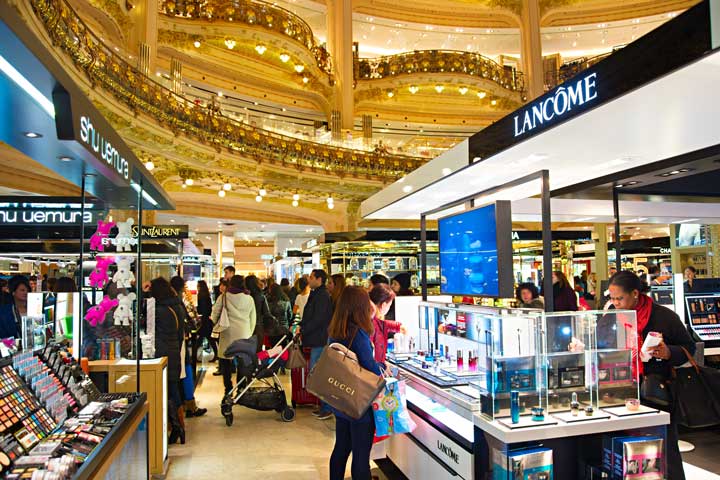
In the 1700s, there was a shift from primary economic activities like agriculture, mining, etc. to secondary sector constituting manufacturing, construction, etc. This shift was primarily facilitated by the Industrial Revolution which was kickstarted in the Great Britain. Consequently, on similar lines, the ICT revolution enabled a shift from secondary to tertiary sector which predominantly constituted of service-oriented economic activities. One of the biggest industries that emerged out of the tertiary sector was the travel and tourism industry.
What is Travel Retail and Why is it on the Rise Since the Last Few Years?
In the last few decades, especially after the opening of majority of the global economies post-1991, travel and tourism industry has grown like anything else. Some economists even consider it to be a separate economic sector altogether. On account of this growth, several subsidiary and standalone industries have propped up and thrived under the travel and tourism sector. One such standalone industry is the global travel retail industry. Travel retail pertains to creating, planning, and providing travel services, while at the same time, engaging in sales activities to cater to the shoppers’ demands while they are in transit.
The growth in the travel retail market is mainly attributed to four main factors which are discussed below:
- Boom in the Travel Industry on the Whole
Except the aberration witnessed in the last two years due to the Covid-19 pandemic, there has been a steady growth in the number of people travelling across the globe. Though the reasons for travel might be different for each individual, the travel retail industry has been able to fulfill their varied demands efficiently. Hence, a growth in the travel industry has been mirrored by the travel retail industry. Also, since people have been exploring countries and places that were previously not so often visited, the travel retail industry has found new ways and avenues to offer their services.
- Travelers Tend to Shop More
Studies by various behavioral economists have shown that travelers, especially the ones going out for vacations, tend to shop more. This shift from a thrift behavior, according to these experts, is due to the leisurely atmosphere and stress-free state of mind. Also, since travelers have a lot of free time at their disposal, they can shop for longer periods of time. Another interesting theory as to why people spend more at transit channels, such as airports , is that the infrastructure inside airports is built on the concept of open-plan setups. As a result, luxury shopping and casual shopping spaces are intertwined in each other, thus blurring the lines between the two.
- Accurate Data Insights
The retailers engaging in travel retail and sales activities have an added advantage of accurate information about their customers. Their travel and departure times, the type of aircrafts they are travelling, their destination, etc. helps the retailer in getting a brief idea as to what the traveler might be looking for. This helps these retailers to plan their sale strategy accordingly, which helps in maximizing their profits. Also, providing customer service to the passengers or people in transit becomes much easier due to these vital data points.
- Better Showcasing of Products
Since travelers tend to shop more products and spend more on luxury items during their travel, they tend to appreciate certain products more than in normal circumstances. This provides the companies and travel retailers to showcase their products and test whether the products are sellable. Hence, various international brands of different sectors tend to launch and market their unique products through the travel retail industry.
Future of Travel Retail Industry
Though the Covid-19 pandemic and the subsequent lockdowns put a strain on the travel and the travel retail industries, market analysts are confident that both these industries will register huge growth rates in the post-pandemic world. Also, digitization of financial services has improved the quality of shopping experience at the transit channels and has helped in reducing the complexities associated with foreign currency exchange. Moreover, the introduction of smart technologies has further improved data collection, which has helped travel retailers to improve their business strategies in a much better way. All these factors point toward a great future of the global retail travel industry.
About the Author(s)

Princy A. J
Princy holds a bachelor’s degree in Civil Engineering from the prestigious Tamil Nadu Dr. M.G.R. University at Chennai, India. After a successful academic record, she pursued her passion for writing. A thorough professional and enthusiastic writer, she enjoys writing on various categories and advancements in the global industries. She plays an instrumental role in writing about current updates, news, blogs, and trends.
Related Post
How popularly do capsule hotels takeover the position of conventional hotels in developed countries, why camping and caravanning are becoming more popular than ever, how does adventure tourism turn a person’s world around, which top 3 companies are in the process of designing world-class urban air mobility.

How is Cybersecurity Becoming a Vital Measure to Combat Emerging Threats in the Banking Sector Globally?

Wood Pellet Biomass Boilers: An Eco-Friendly Heating Solution

5 Ways Vanilla Oil Can Transform Your Life

Discovering the Magic of Toasted Flour: Why & How to Use It
Request Sample Form

Subscribe to our newsletter and get our newest updates right on your inbox.
Blog Name Here
Obtain comprehensive insights on the Travel Retail Industry
Preview an Exclusive Sample of the Report of Travel Retail Market

The Company
- Why Research Dive?
- Research Methodology
- Syndicate Reports
- Customize Reports
- Consulting Services
- Design your research
- GDPR Policy
- Privacy Policy
- Return Policy
- Delivery Method
- Terms and Condition
30 Wall St. 8th Floor, New York, NY 10005 (P).
- + 1-800-910-6452 (USA/Canada) - Toll Free
- + 1-888-961-4454 (USA/Canada) - Toll - Free
- +1 (917) 444-1262 (US) - U.S
- [email protected]
Get Notification About Our New Studies
- © 2024 Research Dive. All Rights Reserved

Ready for departure: How the travel retail sector can succeed in the post-Covid environment
By Gabriel Schillaci
Recommendations and case studies for airports and retailers
Like all aviation-related industries, the travel retail sector has been turned on its head by the Covid-19 pandemic. A change in the passenger mix at airports, as well as longer idle times due to Covid-related delays, are driving new trends and behaviors. Digital channels are becoming increasingly important, for example, and shoppers are buying more because shops are quieter. Travel retailers need to adapt to these changes, or risk being left behind. In this article we assess the transformation taking place in the sector and present a series of recommendations for airports and retailers on how they can not only adapt to the new challenges, but also thrive. We also offer two case studies outlining successful Roland Berger travel retail projects.
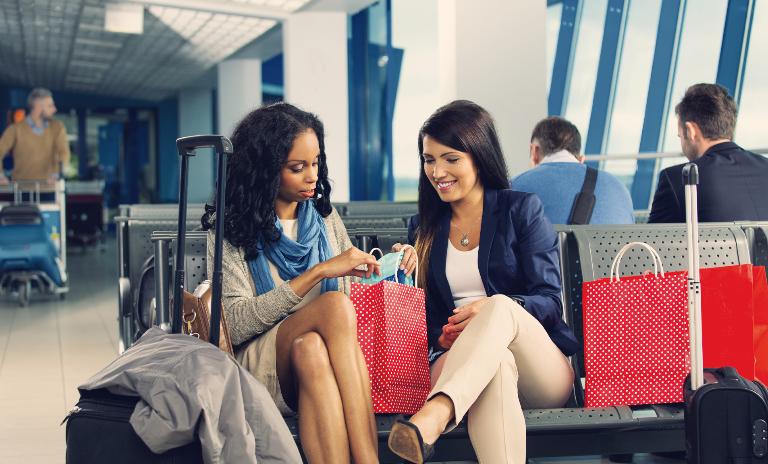
"Airports, retailers and the entire ecosystem must embrace the new market dynamics."

The Covid-19 pandemic has likely changed the air travel market for some time to come. Business travel has been decimated as workers switch to virtual mobility tools, one in five private travelers are choosing to fly domestically rather than internationally and passenger demand is set to remain well below pre-Covid forecasts for years to come, according to a recent Roland Berger study.
While airlines and airports have borne the brunt of the crisis, this reshuffled passenger mix has also had a profound impact on the travel retail sector. For example, fewer big-spending intercontinental passengers from Asia or Brazil mean fewer high-end sales, with retailers now having to adapt their offer to better suit the growing proportion of continental / domestic passengers, and especially low-cost passengers. On the other hand, less traffic and strong concerns over Covid-related delays at airports mean passengers are spending longer periods in airports, pushing up idle times available for shopping.
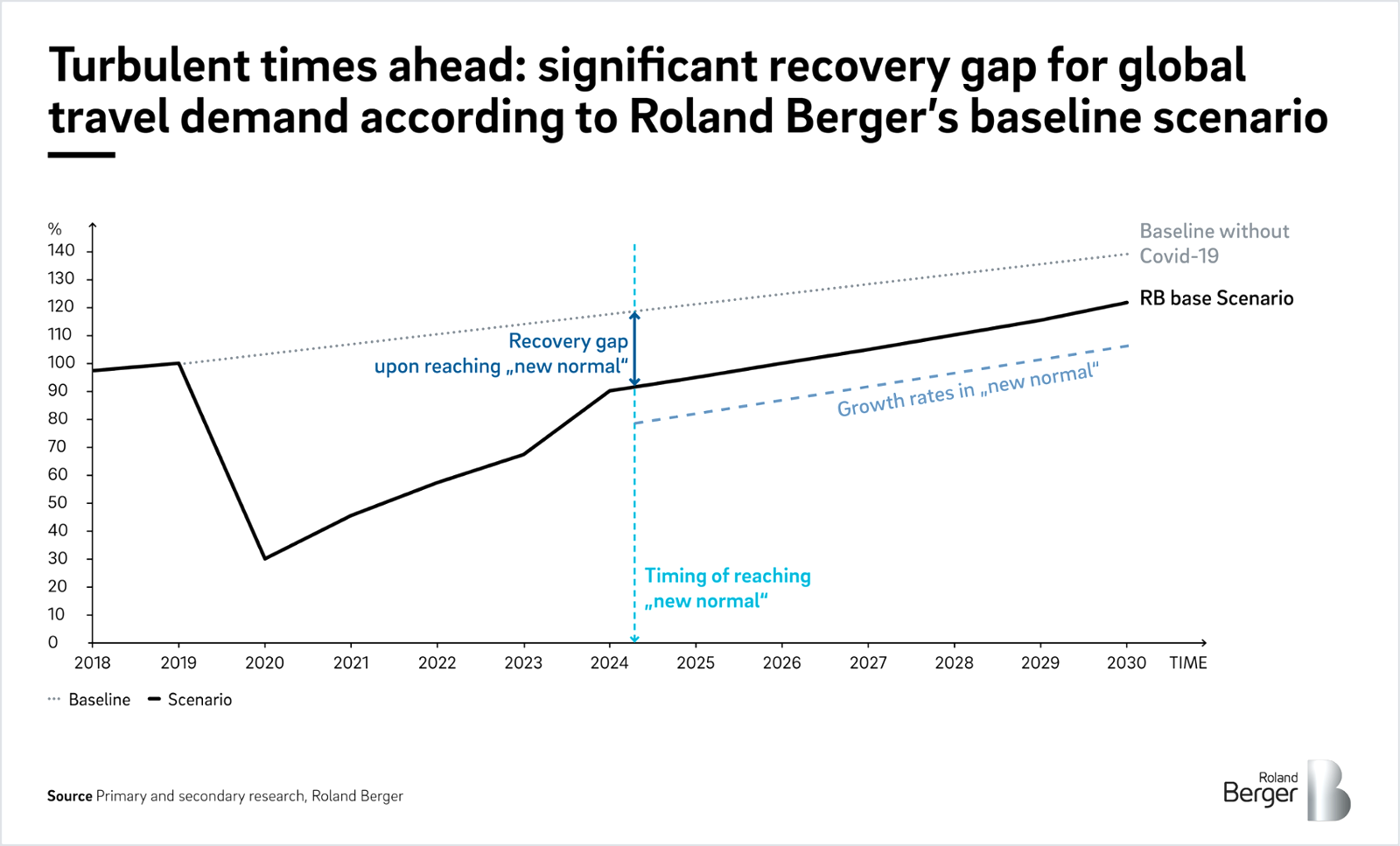
"Airports need to refocus their offer on their core passengers. They must adapt their product assortment and merchandizing to target the growing share of low-cost passengers."

New trends = new behaviors
This shift has accelerated several trends in travel retail, some that existed pre-Covid and some a result of the pandemic. First, the digital effect has become more pronounced. Retailers’ and brands’ omnichannel strategies are increasingly influencing clients, and e-commerce is driving up pricing transparency. Second, new forms of competition, such as social media use and music and video streaming are vying for passengers’ idle time. Third, the range of offers at some airports, which for years have been focused on either luxury or high-volume items, are becoming less attractive. Fourth, passengers now expect more than just traditional airport “shopping”, with demand growing for experience-based events, especially virtual ones. Finally, opportunities are growing to capture and exploit passenger data.
These trends and the reshuffled passenger mix are driving changes in buyer behavior. With less traffic in airports, passengers are buying more because the quieter environment makes it more appealing to spend time in airport shops. Increased idle times also mean they stay longer. In addition, better price transparency means that passengers can more easily compare duty free offers against online or Main Street prices, and dismiss offers that are not the bargain they purport to be.
Recommendations: How can travel retailers adapt?
The upshot is that travel retail players need to adapt to survive. In short, airports, retailers and the entire ecosystem must embrace the new market dynamics. To do this, we believe they need to focus on two key areas: revamping their traditional offer and reinventing their business models. Below we give our recommendations.
"Collaboration between airlines, airports and travel retailers is essential to realize the potential of new business models."

Revamp the offer
Refocus on core passengers: Travel retailers know that some passengers spend more than others. Their traditional offer has always included a premium element (designer stores, upmarket boutiques and restaurants, etc.) to cater to them. But this low volume/high value market has been badly hit by travel restrictions placed on some of its biggest spenders, such as Asian or Brazilian passengers. As a result, airports need to refocus their offer on their core passengers. They must adapt their product assortment and merchandizing to target the growing share of low-cost passengers, who while traveling low cost, do not necessarily have lower purchasing power at the airport.
Renew formats: To stay fresh, travel retailers need to frequently reinvent their formats. These might include pop-up stores, shop-in-shops, live performances and games. Integrating modularity into the design of commercial spaces helps with this.
Modernize concepts: A purely transactional approach to travel retail is no longer enough. Players must develop concepts such as retail-as-a-media, where capturing data points on passengers is more valuable than making a sale. This involves showcasing, for example, electronics, with customers able to try out new products provided they register first.
Offer experiences: Memorable events can improve brand awareness, customer relations and sales. With their captive audiences, airports provide a perfect platform for surprising, entertaining events, such as concerts, virtual reality experiences and selfie-worthy backdrops.
Leverage data and AI: Good use of data can help turbocharge a retailer. For example, ultra-personalization can help to cement client relationships and performance can be improved by closely monitoring datapoints and adapting to changes accordingly.
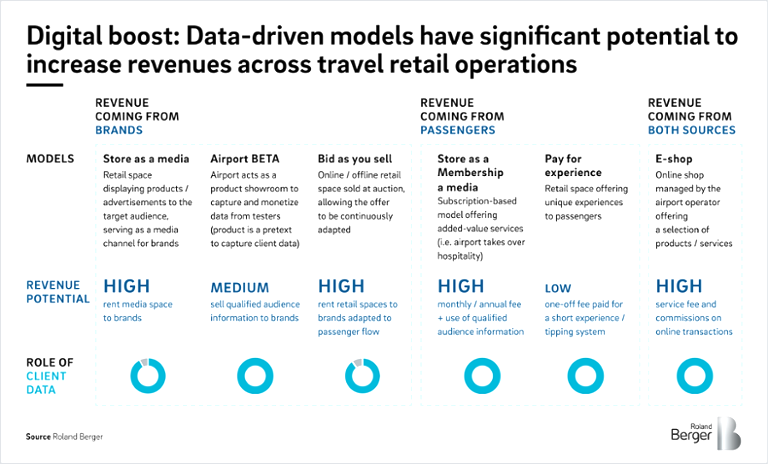
"Our expert teams have considerable knowledge of travel retail, and have supported airports, travel retailers, brands and airlines through a host of strategic and operational challenges."

Reinvent business models
Leverage cooperation and value sharing: Collaboration between airlines, airports and travel retailers is essential to realize the potential of new business models. This could include developing loyalty cards for a retailer or airline, or a branded payment card for a retailer.
Case studies: Roland Berger success stories
Our expert teams have considerable knowledge of travel retail, and have supported airports, travel retailers, brands and airlines through a host of strategic and operational challenges. The following case studies highlight two recent success stories. Feel free to get in touch for more information.
Case study 1: Airport
Project: A well-known European airport had a bottleneck in travel retail sales growth. Roland Berger was tasked with identifying the root cause and finding a transformation solution.
Approach: A comprehensive internal diagnosis identified declining sales per passenger as the root cause. Key factors behind this included passengers perceiving the retail offer to be expensive, an indifferent quality of assortment, insufficient consumer traction and a below-average commercial footprint.
Benchmarking against best practices at the airport’s leading competitors revealed it needed to step up to remain competitive. As such, we designed a commercial strategy with six key focus areas:

Case study 2: Duty-free retailer
Project: A leading Asian duty-free player wanted to win a concession in a major airport in Japan.
Approach: We conducted a thorough analysis of the retail RFP issued by the airport and compared it to the airport's specificities to determine the perfect requirements of its retail business. We identified three key needs, and proposed three corresponding KSFs:
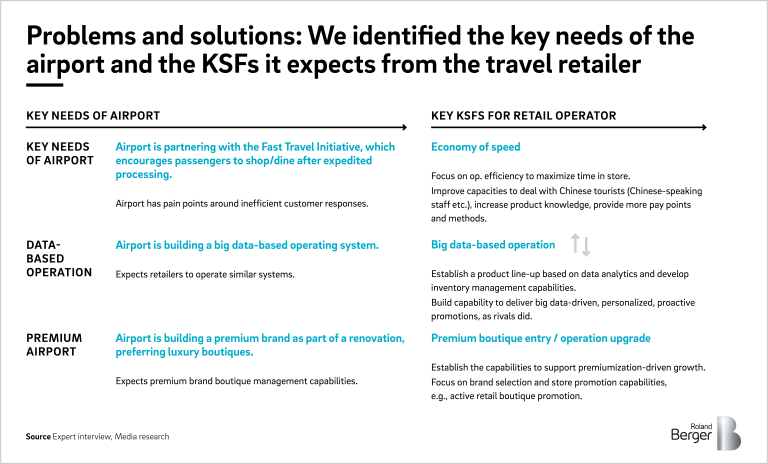
Partial recovery: How three trends are changing long-distance travel
We calculated the impact of three trends on four key travel dimensions to determine the "recovery gap" between pre-crisis long-distance travel and the post-pandemic situation.
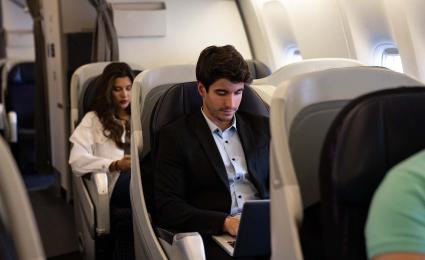
The future of long-distance mobility: How Covid jolted long-distance business travel
The outbreak of Covid-19 affected especially long-distance business traveling which is shown by a 66% globally decrease in air traffic last year.

The future of long-distance mobility: How Covid changed consumer appetites
The first part of our article series on long-haul mobility examines how private travel has forever changed, and why European demand might not return until 2025.

Transportation, Tourism & Logistics
Roland Berger supports the mobility and logistics industry in digitization along the entire value chain.

Smart Mobility
Smart Mobility contributes to a more sustainable and value-adding state of mobility. Find out more about new mobility scenarios for our society here.

- Publications
- Recommendations for successful travel retail
Select a market
- South Korea
- Netherlands
- New Zealand
- Philippines
- Switzerland
Please leave a message
- Fast Moving Consumer Goods
- Food Services
- Luxury & Lifestyle
Access a full range of integrated solutions to support your business growth.
Stay updated with our latest insights on Asia and beyond.
- Pharmaceuticals
- OTC & Consumer Health
- Medical Devices
- Commercial Services
- Patient Services
- Distribution Services
- Regulatory Services
- Food & Beverage Ingredients
- Personal Care Ingredients
- Pharmaceutical Ingredients
- Specialty Chemicals
- Innovation and Formulation
- Distribution
- Commercial and Industrial Applications
- Precision Machinery
- Scientific Solutions
- Semiconductor & Electronics
- Market Analysis and Strategies
- Marketing and Sales
- Application Engineering
- Distribution and Logistics
- After-Sales Services
Our products
Search our product database.
Accessing a global sourcing network.
Market insights
Generating ideas for growth.
Marketing and sales
Opening up new revenue opportunities.
Distribution and logistics
Delivering what you need, when you need it, where you need it.
After-sales services
Servicing throughout the entire lifespan of your product.
Learn about our global hub for Digital & IT services.
- Global website Australia Brunei Cambodia Canada China Finland Denmark France Germany UK Guam Hong Kong India Indonesia Italy Japan South Korea Laos Latvia Hong Kong Malaysia Myanmar Netherlands New Zealand Philippines Poland Portugal Singapore Spain Sri Lanka Sweden Switzerland Taiwan Thailand USA Vietnam
- Sustainability
- Our expertise
Five potential indicators for the future of travel retail
“Experiences are more important than possessions.” This has become a mantra of Asia’s tourism industry as it seeks to understand how travel behaviors may evolve post-pandemic.
The underlying precept is that travelers may want to escape to nature, to experience freedom in serene landscapes rather than spend time shopping when travel bans are eventually lifted. Tourists radiating away from urban centers could dampen the much-hoped-for revival of travel retail spending.
Yet, predicting future trends in Asian travel is risky. Having been unable to fly beyond borders for 15 months and counting may mean that caution and safety remain paramount, at least initially. Alternatively, grounded travelers may take to the skies in large numbers as soon as the airport gates are opened.
But when travel does resume, will “revenge spend” travelers stimulate visitor economies once more? And how should businesses prepare? At the same time, has skyrocketing pandemic-era growth in eCommerce altered travel retail forever? If so, what new spending patterns could emerge?
Amid the current uncertainty, here are five factors to consider:
1. Charting domestic consumer spending
There will be a temptation to compare reopening travel retail activity with 2019, the last year for which measurable data is available. A more effective way to benchmark spending patterns soon will be to analyze domestic Asian markets in 2020 and 2021.
Scrutinizing vacation expenditure flows in markets that enjoyed strong domestic travel during the pandemic such as China, Vietnam, South Korea and Taiwan will help gauge the degree to which consumer sentiment is shifting either temporarily or long term.
Although, shopping priorities for domestic tourists tend to differ from when they travel overseas, analyzing local consumer markets can provide buying insights that are otherwise missing.
- Unlocking travel spend will require retailers to scrutinize realigned consumer attitudes and purchasing triggers during the pandemic
- Pre-COVID-19, domestic tourism was frequently overlooked as a guide to how travelers might behave and purchase when they take an overseas vacation
- eCommerce demand has grown and diversified and may continue while on vacation. Travelers may, for instance, use local shopping sites to buy daily use items
2. Watching the Hainan experience
China has proved to be a rare holiday retail hotspot in Asia during COVID-19. Hainan Island, which is China’s offshore duty-free shopping destination, has delivered impressive results since domestic travel reopened last summer.
Although visitors to Hainan from China fell 22 percent in 2020, there were still nearly 65 million visitors and sales of duty-free items increased by 127 percent from 2019. With COVID-19 under control, Chinese travelers are displaying more confidence to travel and shop using e-payment apps such as AliPay and WeChat Pay.
In the first quarter of 2021, Hainan recorded duty-free sales of RMB 13.6 billion, a spectacular 356 percent increase in the same 2020 period.
- To boost travel retail during the pandemic, China increased the annual tax-free shopping limit for its travelers visiting Hainan Island on vacation
- The enhanced sales cap helped expand the volume of duty-free sales and encouraged brands and retailers to unveil new products and promotions in Hainan
- Monitoring domestic trends are important as the proven spending power of Chinese travelers will likely drive retail competition once international tourism restarts
3. Innovating in travel shopping
While international travel has been on pause in most of Asia since March 2020, imaginative solutions have been tested to promote travel shopping. In South Korea, “flights to nowhere” by seven local airlines take off and return to the same Korean airport without landing elsewhere. However, each flight route crosses into Japanese airspace enabling passengers to purchase tax-free items at the airport as if taking an international flight.
We are also starting to see an acceleration of duty-free shopping beyond airport outlets. South Korea’s Lotte plans to open a duty-free store in downtown Hanoi in 2021, followed by Da Nang. This follows the opening of Lotte city outlets in Melbourne and Tokyo. Meanwhile, Da Nang plans to build an international duty-free zone to attract luxury shoppers and tourists, and bolster the visitor economies of nearby destinations like Hue and Hoi An.
- Introducing new duty-free formats will help cosmetics, fragrance, jewelry and drinks brands to tap pent-up “revenge spend” and breathe new life into travel retail
- Pre- and post-flight stores will likely diversify and regularly refresh their product ranges to tempt travelers to make in-the-moment purchases
- Offering duty-free shopping in downtown locations could generate more foot traffic and benefit existing retailers in the initial post-pandemic period
4. Making travel payments seamless
During COVID-19, Asian consumers have relied on smartphone shopping and payment apps. The frictionless safety of cashless transactions is here to stay. Ongoing development of digital currencies should also make it smoother and more secure for travelers to make touchless purchases while overseas.
As mentioned in our previous article five reasons why digital currencies will influence consumer behaviors , Cambodia, Thailand and Malaysia plan to standardize cross-border payments, and Thailand and Vietnam may introduce a QR code payment app for tourists from each country. Meanwhile, JPMorgan is trialing an international payments tool using Blockchain in Indonesia and Taiwan, and Vietnam’s e-wallet apps Sacombank Pay and Liên Việt 24h signed with Lotte Duty-free to help tourists shop without cash and enjoy customized promotions.
Offering digital payment options that are safe, secure and seamless are important for enticing Asian consumers to spend while traveling
Creative promotions incorporating elements of personal participation and gamification may help retailers and brands unlock latent travel spend
Asia’s digital wallet and e-currency landscape is changing fast, and retailers will need to adapt quickly to a dynamic and unpredictable cashless future
5. Buying into the travel experience
Despite widespread social restrictions, brand innovation has gained a new impetus during the pandemic with a focus on local consumers. The Made in Vietnam campaign has inspired young creatives from Hanoi to Ho Chi Minh City to launch stylish lifestyle accessories and organic products reflecting both local culture and people’s pandemic-era experiences.
In Indonesia, the Philippines and Malaysia, artistically branded product lines reflect the shifting zeitgeist. Meanwhile, international clothing and footwear brands are commissioning local artists to create uplifting designs for limited-edition releases. Social media advocacy may result in some of these innovations becoming coveted in the future by inbound visitors seeking “sense of place” shopping experiences.
Travel consumers will be on the lookout for unique, locally produced mementos that combine the culture and creative renaissance of their chosen destination
Gift giving is popular with Asian tourists and post-pandemic travelers will desire locally branded items launched during a time when travel overseas was not possible
Destinations boasting clearly defined brand appeal, such as whisky in Japan, cosmetics in South Korea and organic products in Australia and New Zealand, may experience strong travel shopping demand
Related stories

VR and storytelling: a fairy tale ending

NFTs Are Hitting All the Right Notes in Southeast Asia

Five Reasons Why Digital Currencies Will Influence Consumer Behaviors

Five Factors Driving Digital Expansion in Southeast Asia
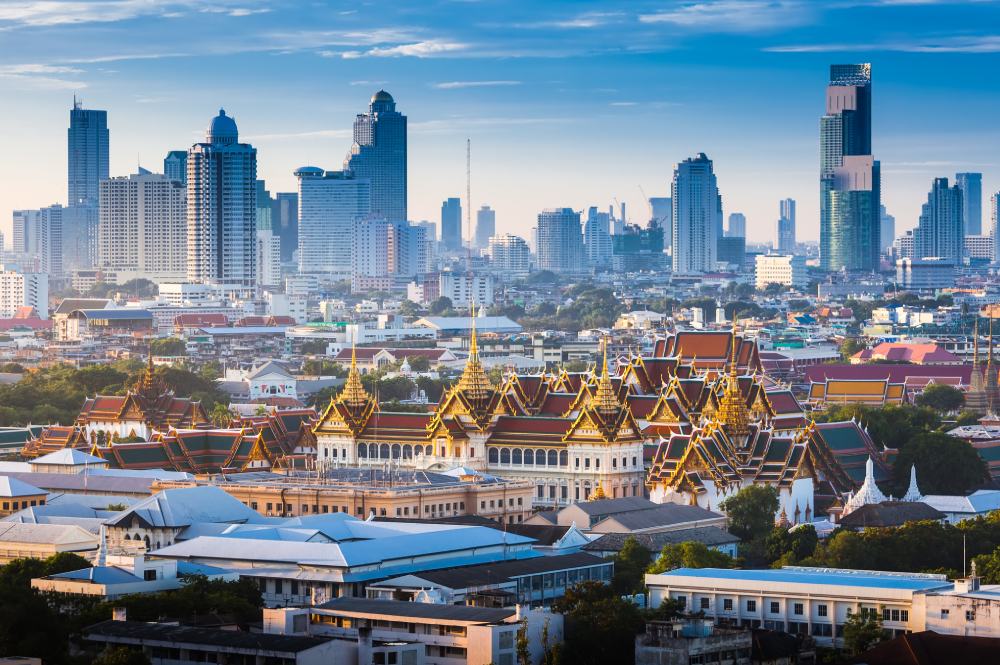
Four Factors Driving Southeast Asia’s Economic Future
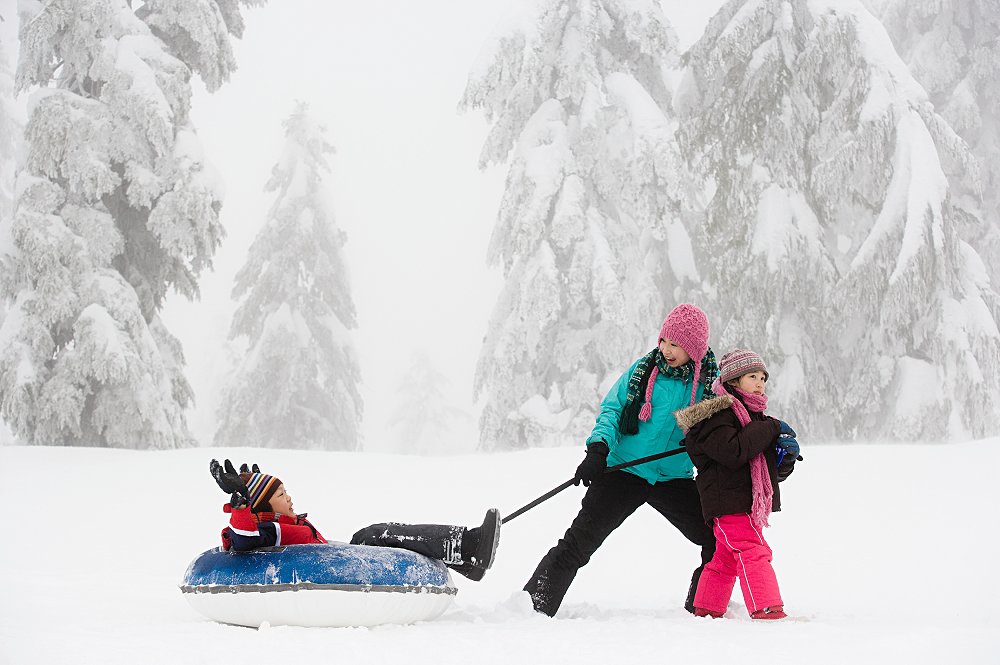
Five Reasons Why “Escape to Nature” Will Be a Hot Topic in 2022

Switzerland Tops the List of World’s Most Innovative Markets
Related links.
- Global website
"People want to travel": 4 sector leaders say that tourism will change and grow

The global travel and tourism industry's post-pandemic recovery is gaining pace as the world’s pent-up desire for travel rekindles. Image: Unsplash/Anete Lūsiņa
.chakra .wef-1c7l3mo{-webkit-transition:all 0.15s ease-out;transition:all 0.15s ease-out;cursor:pointer;-webkit-text-decoration:none;text-decoration:none;outline:none;color:inherit;}.chakra .wef-1c7l3mo:hover,.chakra .wef-1c7l3mo[data-hover]{-webkit-text-decoration:underline;text-decoration:underline;}.chakra .wef-1c7l3mo:focus,.chakra .wef-1c7l3mo[data-focus]{box-shadow:0 0 0 3px rgba(168,203,251,0.5);} Anthony Capuano
Shinya katanozaka, gilda perez-alvarado, stephen kaufer.
Listen to the article
- In 2020 alone, the travel and tourism industry lost $4.5 trillion in GDP and 62 million jobs - the road to recovery remains long.
- The World Economic Forum’s latest Travel & Tourism Development Index gives expert insights on how the sector will recover and grow.
- We asked four business leaders in the sector to reflect on the state of its recovery, lessons learned from the pandemic, and the conditions that are critical for the future success of travel and tourism businesses and destinations.
The global travel and tourism sector’s post-pandemic recovery is gaining pace as the world’s pent-up desire for travel rekindles. The difference in international tourist arrivals in January 2021 and a similar period in January 2022 was as much as the growth in all of 2021. However, with $4.5 trillion in GDP and 62 million jobs lost in 2020 alone, the road to recovery remains long.
A few factors will greatly determine how the sector performs. These include travel restrictions, vaccination rates and health security, changing market dynamics and consumer preferences, and the ability of businesses and destinations to adapt. At the same time, the sector will need to prepare for future shocks.
The TTDI benchmarks and measures “the set of factors and policies that enable the sustainable and resilient development of the T&T sector, which in turn contributes to the development of a country”. The TTDI is a direct evolution of the long-running Travel and Tourism Competitiveness Index (TTCI), with the change reflecting the index’s increased coverage of T&T development concepts, including sustainability and resilience impact on T&T growth and is designed to highlight the sector’s role in broader economic and social development as well as the need for T&T stakeholder collaboration to mitigate the impact of the pandemic, bolster the recovery and deal with future challenges and risks. Some of the most notable framework and methodology differences between the TTCI and TTDI include the additions of new pillars, including Non-Leisure Resources, Socioeconomic Resilience and Conditions, and T&T Demand Pressure and Impact. Please see the Technical notes and methodology. section to learn more about the index and the differences between the TTCI and TTDI.
The World Economic Forum's latest Travel & Tourism Development Index highlights many of these aspects, including the opportunity and need to rebuild the travel and tourism sector for the better by making it more inclusive, sustainable, and resilient. This will unleash its potential to drive future economic and social progress.
Within this context, we asked four business leaders in the sector to reflect on the state of its recovery, lessons learned from the pandemic, and the conditions that are critical for the future success of travel and tourism businesses and destinations.

Have you read?
Are you a 'bleisure' traveller, what is a ‘vaccine passport’ and will you need one the next time you travel, a travel boom is looming. but is the industry ready, how to follow davos 2022, “the way we live and work has changed because of the pandemic and the way we travel has changed as well”.
Tony Capuano, CEO, Marriott International
Despite the challenges created by the COVID-19 pandemic, the future looks bright for travel and tourism. Across the globe, people are already getting back on the road. Demand for travel is incredibly resilient and as vaccination rates have risen and restrictions eased, travel has rebounded quickly, often led by leisure.
The way many of us live and work has changed because of the pandemic and the way we travel has changed as well. New categories of travel have emerged. The rise of “bleisure” travel is one example – combining elements of business and leisure travel into a single trip. Newly flexible work arrangements, including the opportunity for many knowledge workers to work remotely, have created opportunities for extended travel, not limited by a Monday to Friday “9 to 5” workweek in the office.
To capitalize on this renewed and growing demand for new travel experiences, industry must join governments and policymakers to ensure that the right conditions are in place to welcome travellers as they prepare to get back on the road again, particularly those who cross international borders. Thus far, much of the recovery has been led by domestic and leisure travel. The incremental recovery of business and international travel, however, will be significant for the broader industry and the millions who make their livelihoods through travel and tourism.
Looking ahead to future challenges to the sector, be they public health conditions, international crises, or climate impacts, global coordination will be the essential component in tackling difficult circumstances head-on. International agreement on common – or at least compatible – standards and decision-making frameworks around global travel is key. Leveraging existing organizations and processes to achieve consensus as challenges emerge will help reduce risk and improve collaboration while keeping borders open.
“The travel and tourism sector will not be able to survive unless it adapts to the virtual market and sustainability conscience travellers”
Shinya Katanozaka, Representative Director, Chairman, ANA Holdings Inc.
At a time when people’s movements are still being restricted by the pandemic, there is a strong, renewed sense that people want to travel and that they want to go places for business and leisure.
In that respect, the biggest change has been in the very concept of “travel.”
A prime example is the rapid expansion of the market for “virtual travel.” This trend has been accelerated not only by advances in digital technologies, but also by the protracted pandemic. The travel and tourism sector will not be able to survive unless it adapts to this new market.
However, this is not as simple as a shift from “real” to “virtual.” Virtual experiences will flow back into a rediscovery of the value of real experiences. And beyond that, to a hunger for real experiences with clearer and more diverse purposes. The hope is that this meeting of virtual and actual will bring balance and synergy the industry.
The pandemic has also seen the emergence of the “sustainability-conscious” traveller, which means that the aviation industry and others are now facing the challenge of adding decarbonization to their value proposition. This trend will force a re-examination of what travel itself should look like and how sustainable practices can be incorporated and communicated. Addressing this challenge will also require stronger collaboration across the entire industry. We believe that this will play an important role in the industry’s revitalization as it recovers from the pandemic.
How is the World Economic Forum promoting sustainable and inclusive mobility systems?
The World Economic Forum’s Platform for Shaping the Future of Mobility works across four industries: aerospace and drones; automotive and new mobility; aviation travel and tourism; and supply chain and transport. It aims to ensure that the future of mobility is safe, clean, and inclusive.
- Through the Clean Skies for Tomorrow Coalition , more than 100 companies are working together to power global aviation with 10% sustainable aviation fuel by 2030.
- In collaboration with UNICEF, the Forum developed a charter with leading shipping, airlines and logistics to support COVAX in delivering more than 1 billion COVID-19 vaccines to vulnerable communities worldwide.
- The Road Freight Zero Project and P4G-Getting to Zero Coalition have led to outcomes demonstrating the rationale, costs and opportunities for accelerating the transition to zero emission freight.
- The Medicine from the Sky initiative is using drones to deliver vaccines and medicine to remote areas in India, completing over 300 successful trials.
- The Forum’s Target True Zero initiative is working to accelerate the deployment and scaling of zero emission aviation, leveraging electric and hydrogen flight technologies.
- In collaboration with the City of Los Angeles, Federal Aviation Administration, and NASA, the Forum developed the Principles of the Urban Sky to help adopt Urban Air Mobility in cities worldwide.
- The Forum led the development of the Space Sustainability Rating to incentivize and promote a more safe and sustainable approach to space mission management and debris mitigation in orbit.
- The Circular Cars Initiative is informing the automotive circularity policy agenda, following the endorsement from European Commission and Zero Emission Vehicle Transition Council countries, and is now invited to support China’s policy roadmap.
- The Moving India network is working with policymakers to advance electric vehicle manufacturing policies, ignite adoption of zero emission road freight vehicles, and finance the transition.
- The Urban Mobility Scorecards initiative – led by the Forum’s Global New Mobility Coalition – is bringing together mobility operators and cities to benchmark the transition to sustainable urban mobility systems.
Contact us for more information on how to get involved.
“The tourism industry must advocate for better protection of small businesses”
Gilda Perez-Alvarado, Global CEO, JLL Hotels & Hospitality
In the next few years, I think sustainability practices will become more prevalent as travellers become both more aware and interested in what countries, destinations and regions are doing in the sustainability space. Both core environmental pieces, such as water and air, and a general approach to sustainability are going to be important.
Additionally, I think conservation becomes more important in terms of how destinations and countries explain what they are doing, as the importance of climate change and natural resources are going to be critical and become top of mind for travellers.
The second part to this is we may see more interest in outdoor events going forward because it creates that sort of natural social distancing, if you will, or that natural safety piece. Doing outdoor activities such as outdoor dining, hiking and festivals may be a more appealing alternative to overcrowded events and spaces.
A lot of lessons were learned over the last few years, but one of the biggest ones was the importance of small business. As an industry, we must protect small business better. We need to have programmes outlined that successfully help small businesses get through challenging times.
Unfortunately, during the pandemic, many small businesses shut down and may never return. Small businesses are important to the travel and tourism sector because they bring uniqueness to destinations. People don’t travel to visit the same places they could visit at home; they prefer unique experiences that are only offered by specific businesses. If you were to remove all the small businesses from a destination, it would be a very different experience.
“Data shows that the majority of travellers want to explore destinations in a more immersive and experiential way”
Steve Kaufer, Co-Founder & CEO, Tripadvisor
We’re on the verge of a travel renaissance. The pandemic might have interrupted the global travel experience, but people are slowly coming out of the bubble. Businesses need to acknowledge the continued desire to feel safe when travelling. A Tripadvisor survey revealed that three-quarters (76%) of travellers will still make destination choices based on low COVID-19 infection rates.
As such, efforts to showcase how businesses care for travellers - be it by deep cleaning their properties or making items like hand sanitizer readily available - need to be ingrained within tourism operations moving forward.
But travel will also evolve in other ways, and as an industry, we need to be prepared to think digitally, and reimagine our use of physical space.
Hotels will become dynamic meeting places for teams to bond in our new hybrid work style. Lodgings near major corporate headquarters will benefit from an influx of bookings from employees convening for longer periods. They will also make way for the “bleisure” traveller who mixes business trips with leisure. Hotels in unique locales will become feasible workspaces. Employers should prepare for their workers to tag on a few extra days to get some rest and relaxation after on-location company gatherings.
Beyond the pandemic, travellers will also want to explore the world differently, see new places and do new things. Our data reveals that the majority want to explore destinations in a more immersive and experiential way, and to feel more connected to the history and culture. While seeing the top of the Empire State building has been a typical excursion for tourists in New York city, visitors will become more drawn to intimate activities like taking a cooking class in Brooklyn with a family of pizza makers who go back generations. This will undoubtedly be a significant area of growth in the travel and tourism industry.
Governments would be smart to plan as well, and to consider an international playbook that helps prepare us for the next public health crisis, inclusive of universal vaccine passports and policies that get us through borders faster.
Understanding these key trends - the ongoing need to feel safe and the growing desire to travel differently - and planning for the next crisis will be essential for governments, destinations, and tourism businesses to succeed in the efforts to keep the world travelling.
- Commerce Media Platform The connected commerce media environment for the open internet
- Commerce Growth For marketers & agencies looking for automated acquisition & retention
- Commerce Max For brands & agencies looking for retail media on the open internet
- Commerce Grid For media owners, agencies, and retailers looking to connect media and commerce with programmatic
- Commerce Yield For retailers, marketplaces & commerce companies looking to control, scale, and maximize digital and physical asset monetization
- Addressability Learn about our multi-pronged addressability strategy for the ecosystem
- AI Engine Removes the guesswork to save time and reach your KPIs
- Predictive Bidding Bids based on the predicted value of each user to save you money
- Product Recommendations Intent-based recommendations that drive more sales
- Shopper Graph Connects shopper IDs & commerce data to scale and optimize your campaigns

- Customer Acquisition Reach new people who are likely interested in you but don't know you yet
- Customer Retention Increase customer lifetime value from people who already know you
- Dynamic Retargeting Increase conversions from people who know you with personalized product ads
- Audiences Find and keep your next top customer with the largest commerce dataset
- Video Advertising Drive discovery and engagement with CTV, OTT and online video
- Contextual Advertising Level up your targeting by combining commerce data and contextual data
- Retail Media Reach and convert shoppers with relevant ads near the digital point of sale

- Resource Center Reports, guides, webinars, and more to inform your ad strategy
- Blog Fresh insights on commerce media and digital advertising
- Success Stories How others have realized their goals by partnering with Criteo
- Consumer Trends The latest consumer data for 20 countries and 600+ product categories
- Glossary Definitions of the most common digital advertising terminology
- Support Center FAQs, guides, and more to help you maximize your Criteo campaigns
- Events See where Criteo will be next
- Digital Ad Formats Explore our ad formats for video, adaptive, rich media, and more
- Ad Gallery Real-world examples for a variety of formats, verticals, and regions
- Dynamic Creative Optimization+ Real-time creative decisioning that scales to make sure your ads are seen
- Ad Trust and Safety Maintain the highest level of quality and performance

- Company Get to know Criteo
- Investors Information for investors
- In the News Press releases and mentions
- Diversity, Equity and Inclusion Our DEI pillars, goals, and more
- Sustainability Our approach for a sustainable future
- Product Ethics How we ensure ethical advertising
- Careers Explore open opportunities

Global travel industry trends 2024: Travelers become master planners

So far in 2024, the global travel industry is seeing a significant resurgence, accompanied by a noticeable trend: People are becoming more skilled at planning their trips and are mastering the art of travel.
Equipped with a wealth of online tools, these travelers are tailoring their itineraries to ensure enriching experiences at maximum value. Resources like AI assistants to one-stop-shop booking platforms empower travelers to curate highly personalized getaways.
To understand the state of global travel in 2024, we analyzed Criteo’s dataset from hundreds of travel players and results from a survey of 10,000+ travelers globally. These are the trends that will help advertisers adapt to this year’s evolving landscape.
1. People are surfing the travel surge.
Across all major regions, bookings for air travel soared by double digits year-over-year during the first quarter of 2024, signaling a robust boost in travel for the upcoming months. Air bookings rose +14% in EMEA, +13% in APAC, and +10% in the Americas YoY.
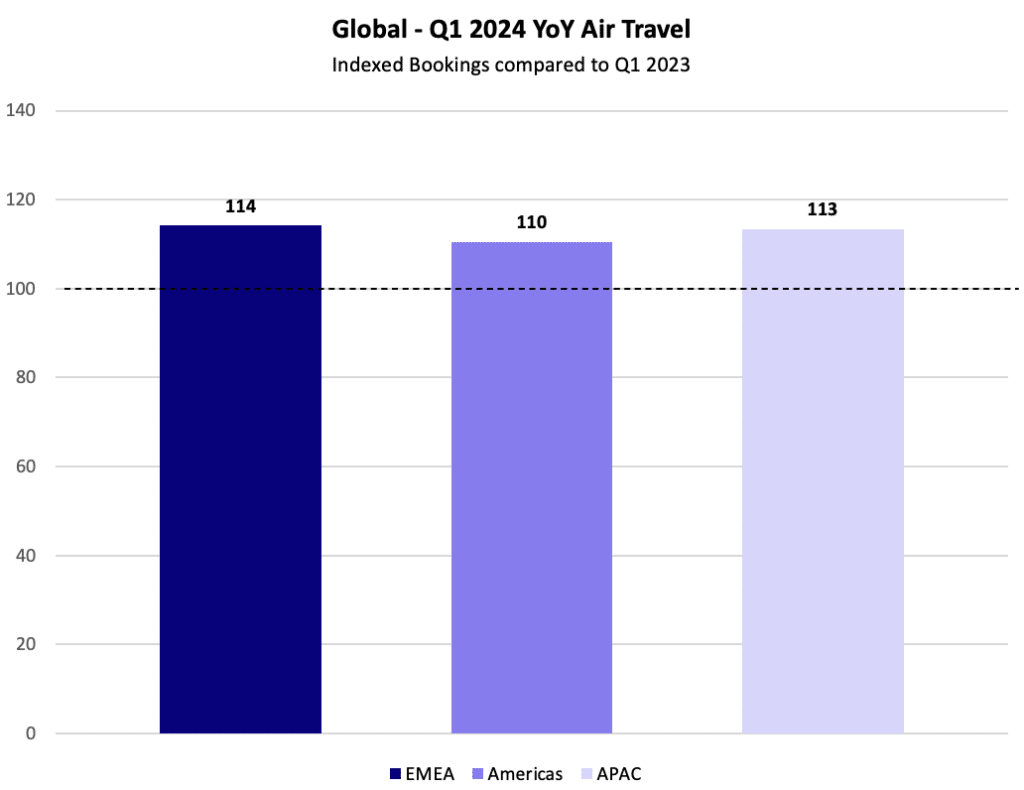
Anticipate a surge in personal getaways this spring and early summer. According to Criteo’s survey, more people around the world plan to travel for leisure or visit friends/family in the next 1-3 months.
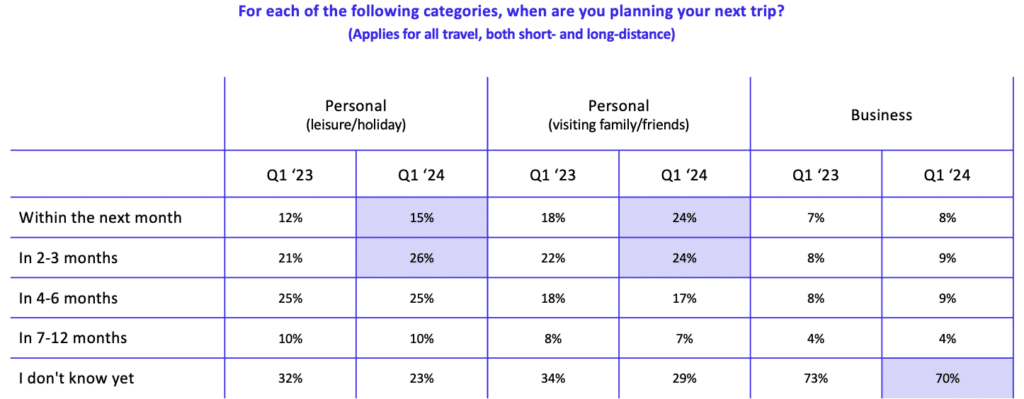
2. AI and booking sites offer algorithmic adventures.
In the past 6 months, more travelers are finding AI tools useful for recommendations—especially for dining experiences, accommodations, and activities. This shift is the strongest among travelers in South Korea, with a 6-point growth when comparing Q3 2023 and Q1 2024.
The adoption of AI tools by travelers is also gaining momentum in Europe. More travelers in Germany (+4 points), France (+4 points), and the UK (+3 points) said they found AI tools useful over the same period.
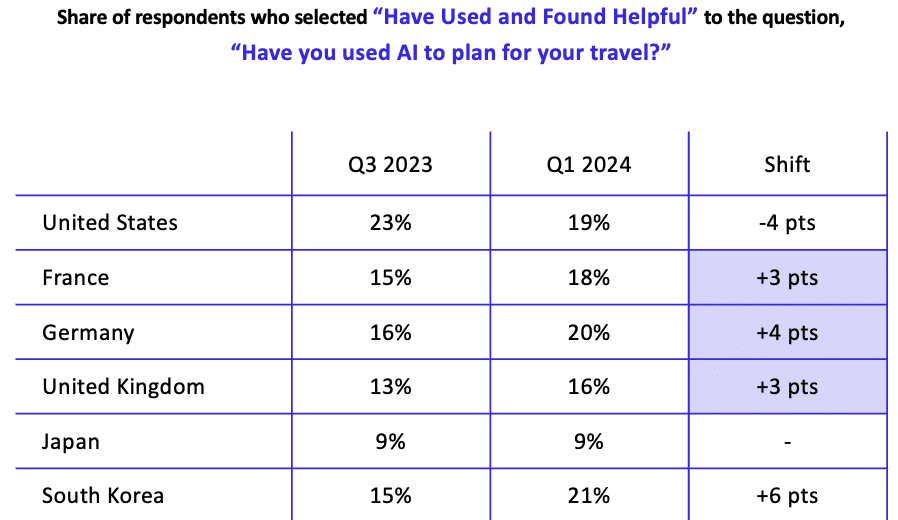
Throughout the online booking journey, travelers are also open to suggestions from travel providers. Half of travelers around the world (48%) get inspiration from travel booking sites.
3. People value personal travel advice.
While assistance from AI and travel booking websites influence the planning journey, travelers still prefer word-of-mouth suggestions. A full 61% of travelers globally said that recommendations from family and friends is a strong decision-making factor. Over one-third of people globally also find inspiration from personal travel content sites like blogs.
Positive reviews are another highly influential factor and are gaining traction. When choosing a travel provider, two-thirds of travelers globally consider positive reviews. This was up 8 points in Q1 2024 compared to in Q3 2023.
4. Travelers are finding ways to adapt to rising costs.
In Q1 2024, 25% of travelers around the world said they spent more on travel within the last six months compared to the same period a year prior.
Rising costs were felt most by travelers in France (+13 points), Japan (+11 points), and South Korea (+8 points).
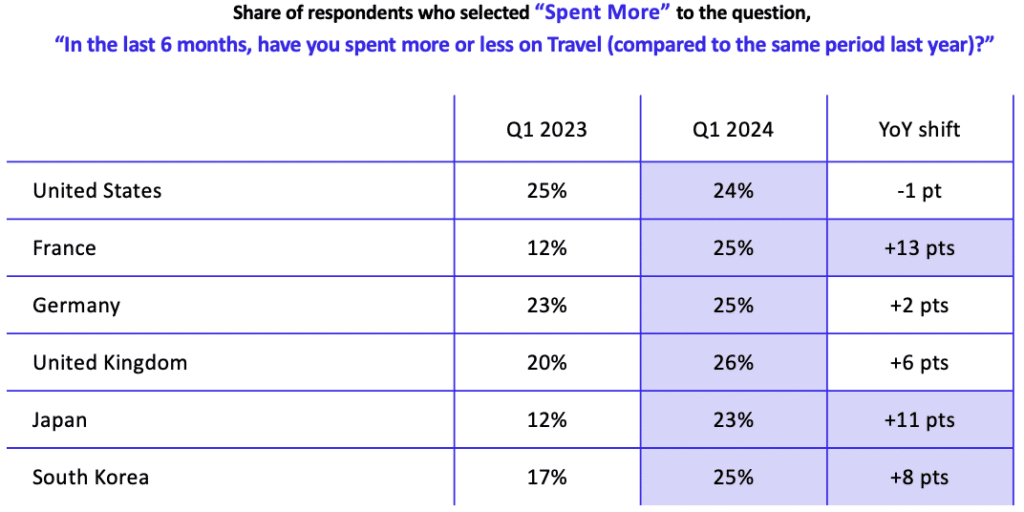
To secure better travel deals, 38% of people globally said they have or would consider changing the timing of their trips. This trend is even more pronounced among travelers in Japan, where 52% are open to adopting this strategy.
One in four travelers worldwide also plan to save money by engaging in fewer activities and opting for more affordable dining experiences. A third of US travelers will also leverage rewards from loyalty programs.
While many travelers aim to cut costs, a growing portion are embracing higher expenditures . A striking 75% of those who spent more on travel in the last six months also splurged on non-essential costs like luxury goods, dining out, health and beauty products, and apparel and accessories.
5. Booking everything from one source offers convenience.
Half of travelers compare multiple (3+) travel providers in search of the best deals.
However, many people prefer to book all travel services from a single source for added convenience and ease of coordination. Three in five travelers globally booked all aspects of their most recent trip—such as flights, hotels, rental cars, and activities—through a single platform, website, app, or provider.
6. Mobile helps travelers embrace their spontaneity.
Travelers enjoy having the freedom to make spur of the moment decisions. Nearly 1in 5 opt to leave some bookings for mid-trip. US travelers lead in flexibility, with 77% stating they booked most aspects of their trip right before departure.
Booking while on-the-go is also popular. In the Americas and EMEA, the share of air travel bookings completed on mobile devices increased by 8 points in March 2023 compared to March 2024. Similarly, there was a 6-point increase in APAC.
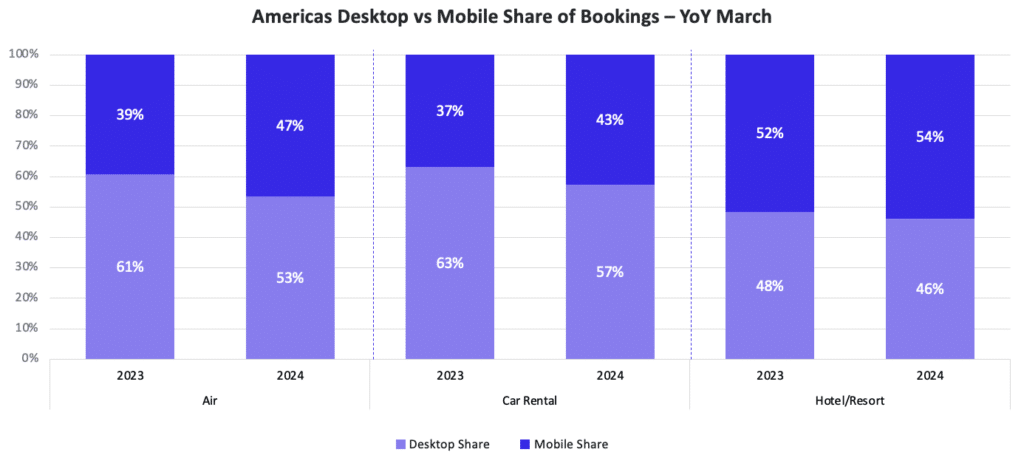
Source: Organic Criteo Data. Americas Travel Partners. Comparing March Bookings in 2023 vs 2024. Desktop and Mobile included, App and Tablet included in Mobile, sample permitting.
Embark on your advertising odyssey
Capturing the attention of travelers demands a highly personalized approach. By crafting ads that directly address their needs and interests—like discounts, loyalty rewards, destination ideas, and activity recommendations—advertisers can boost engagement and bookings.
Given that travelers explore multiple options before making a purchase, a retargeting strategy also helps keeps users engaged until they decide where to go and what they want to experience on their next trip. Meanwhile, retention campaigns can encourage stronger lifetime value as existing travel customers tend to have higher spend compared to first-time buyers.
For more global travel trends, read our full report, Travel Insights: Unpacking the Landscape of the Escape Industry and register for immediate access to our on-demand webinar.
Discover why 19,000+ global clients trust Criteo as their preferred advertising partner.

Elizabeth Kim is a Global Content Strategist captivated by technology, culture, and consumer behavior. Before joining the world of adtech, Elizabeth crafted brand and content strategies at agencies for clients spanning startups to household name giants. Outside of work, Elizabeth finds creative ...
Recommended reading:

How Will Retailers and Brands Utilize Omnichannel?
Retail media, the smart marketer’s guide to customer loyalty, latest resources, the great defrag, criteo’s 2024 addressability strategy, leveraging google’s privacy sandbox with commerce grid, subscribe to our newsletter.
Fresh sales trends and consumer insights to help you plan and win.
Related content
Stay in the know on all things digital marketing

Criteo expands its TAG certifications, ensuring safer digital advertising

10 commerce media truths: The principles behind digital advertising’s hottest opportunity

The state of retail media today: How does your maturity level compare?

Alternative IDs: The future of cookieless advertising?

2024 will be a year of change. Here’s how publishers are gearing up for it.

The Bottom Line of Privacy Sandbox Testing: What You Need to Know
9 questions on modern retailing for travel agencies to ask themselves

Agencies & OTAs
- Around the Industry
- Corporate Travel
- Data & Analytics
- Developers & Startups
- General Blog
Retailing & Merchandising
- Sabre Direct Pay
- Sustainability
- Travel Providers
- Travel Trends
- Traveler Experience
- Modern Retailing
- Sabre Travel AI
- Google Partnership
- Sabre Labs & Research
- News & Views
- Customer Success
- Share on Facebook
- Share on Twitter
- Share on LinkedIn
Are you discussing modern, offer- and order-based travel retailing with other leaders at your agency? Airlines, tech providers, and many travel retailers are figuring out what the future means for them, and now is a great time for you to do the same. Here are nine questions agency leaders should think about.
- What’s new about ‘modern’ travel retailing?
- What do travelers want ?
- What about us? The role of agencies
- How do we build a successful strategy?
- How will our operations need to change?
- What does an effective tech stack include?
- How can tech providers like Sabre help?
- Are airlines making progress?
- The transition: how do we get there?
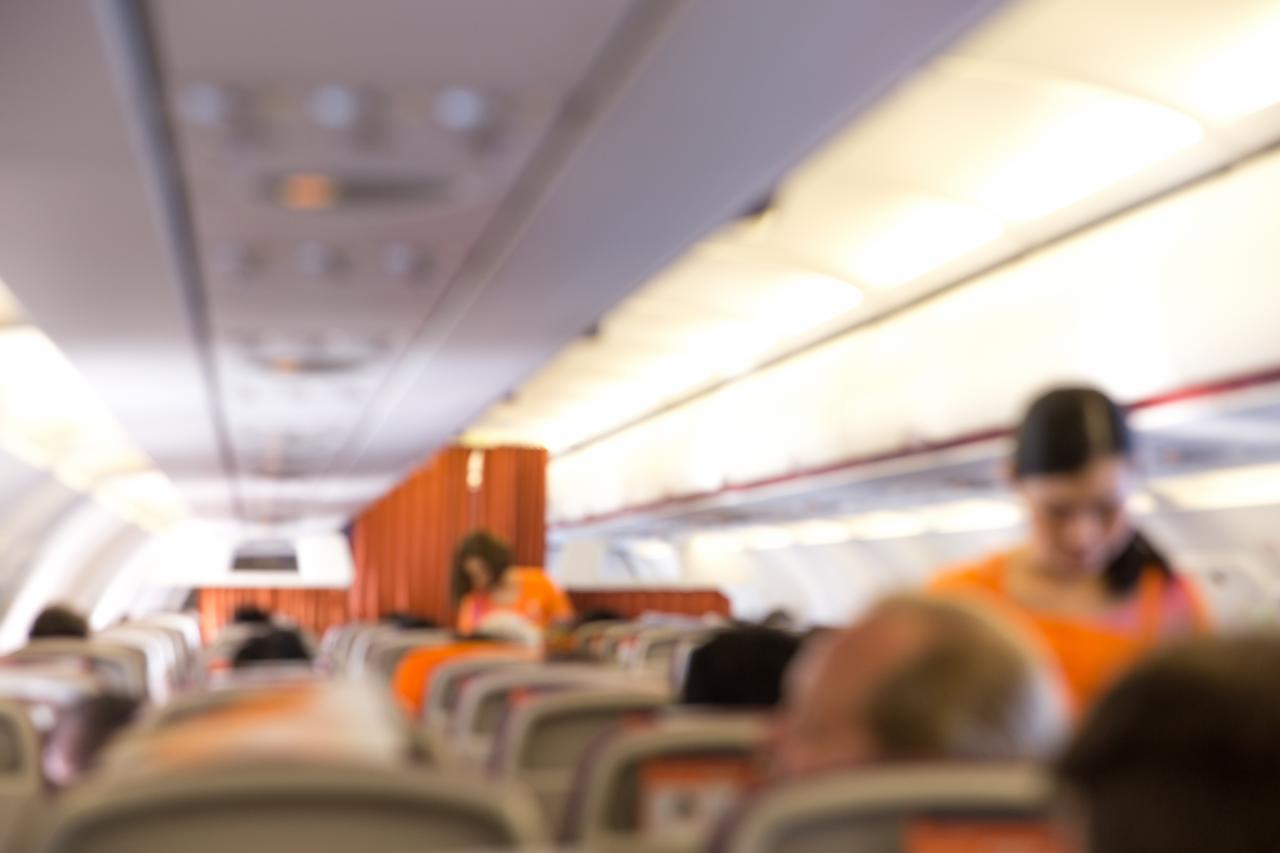
1. What’s new about ‘modern’ travel retailing ?
To get started, it’s helpful to consider the basics….

Travel retailing is the process of selling and servicing travel and related products. ‘Retailing’ goes beyond selling to consider the holistic customer experience, not just a simple transaction.
Modern travel retailing refers to retail experiences that meet and exceed the expectations of today’s travelers. It involves frictionless, intuitive, and personalized shopping, booking, and servicing. The travel industry today is disjointed across stakeholders and falls behind other industries in delivering this level of experience.
Offers and orders is an airline initiative driven by IATA that replaces the traditional sales and service infrastructure between tech providers, travel suppliers, retailers and buyers with a modular infrastructure enabled by offers and orders. It’s underpinned by industry standards: NDC and ONE Order. NDC enables richer messages and content to be sent from an airline to third parties . ONE Order combines PNRs, e-tickets, and electronic miscellaneous documents to be combined in a single record.
Airlines can use these standards to create modern retailing experiences by distributing new content and capabilities through third parties:
- New products and non-air extras beyond traditional ancillaries
- Personalized product bundles tailored with contextual information
- More relevant search results based on traveler profile or persona
- Improved self-service and automated order management
Agency leaders should make sure they understand these opportunities and stay up to date with industry standards to make informed decisions about what it means for their businesses and customers.
2. What do travelers want?
Offers and orders is an airline initiative driven by IATA that replaces the traditional sales and service infrastructure between tech providers, travel suppliers, retailers and buyers with a modular infrastructure enabled by offers and orders. It’s underpinned by industry standards: NDC and ONE Order. NDC enables richer messages and content to be sent from an airline to third parties. ONE Order combines PNRs, e-tickets, and electronic miscellaneous documents to be combined in a single record.
3. What about us? The role of agencies
In Stuck in the middle seat: how agencies can take control of their future , we looked at the role and perspectives of agencies in the evolving airline distribution landscape. We considered how the bulk of development work needed for the industry to transition to offer and order-based retailing relies on airlines and tech providers.

But agencies aren’t necessarily on the sidelines. They are expected to account for more than 40% of gross airline bookings this year, representing hundreds of millions of customer interactions. This gives agencies a strong position from which to understand and address customer needs.
In a future enabled by offers and orders, the scope of travel retailing and customer experiences will broaden beyond what’s possible today. Many agencies are already delivering intuitive and personalized retailing experiences, and they can use the industry’s transformation as an opportunity to innovate further: redefine their role in the ecosystem, streamline processes, deepen relationships with customers, and open new partnership and revenue opportunities.
As we’ve seen recently with tech giants like Google, Microsoft, Meta and Baidu launching artificial intelligence (AI) products in quick succession, the travel industry will reach a tipping point in the next few years when modern retailing experiences become table stakes. Agency leaders need to start thinking about how to position themselves in the travel industry of the future.
4. How do we build a successful strategy?

Offer- and order-based retailing, enhanced by AI/ML solutions, presents new ways for agencies to interact with customers. New products, more relevant offers, richer content displays, and streamlined servicing all influence conversion rates, revenue opportunities, customer satisfaction and loyalty.
To capitalize on new opportunities and stay competitive, agency leaders should think about implications to their business strategies:
- Value proposition and service offerings
- Customer acquisition and loyalty tactics
- Target customer segments and marketing activities
- Product scope beyond flights and traditional ancillaries
- Supplier contracts and partnerships for new ancillaries and non-air products and services
- Supporting NDC in requests for proposals/information from corporations
- Retailing and communication opportunities throughout the customer journey
5. How will our operations need to change?
Agencies’ organizational structures and operations will need to adapt for new retailing capabilities. Orders will become more complex as they increasingly feature new products and data from multiple suppliers. Operational processes will change, for example, with the NDC shopping-led workflow and the phasing out of the PNR.
Order management will eventually be more streamlined with a single order record. However, it’s time-consuming for agents in the short-term with disparate servicing capabilities across distribution channels and suppliers.

To minimize disruption and future-proof their businesses, agency leaders need to consider how they operate:
- Organizational and team structures to address new capabilities
- Duty of care responsibilities for increasingly complex orders
- Automation, disruption management, and self-service opportunities
- Redefined service level agreements as the product scope increases
- Training on new reconciliation, accounting, analytics and reporting workflows
- Redeployment of individual travel agents to complex servicing and revenue-generating tasks
6. What does an effective tech stack include?
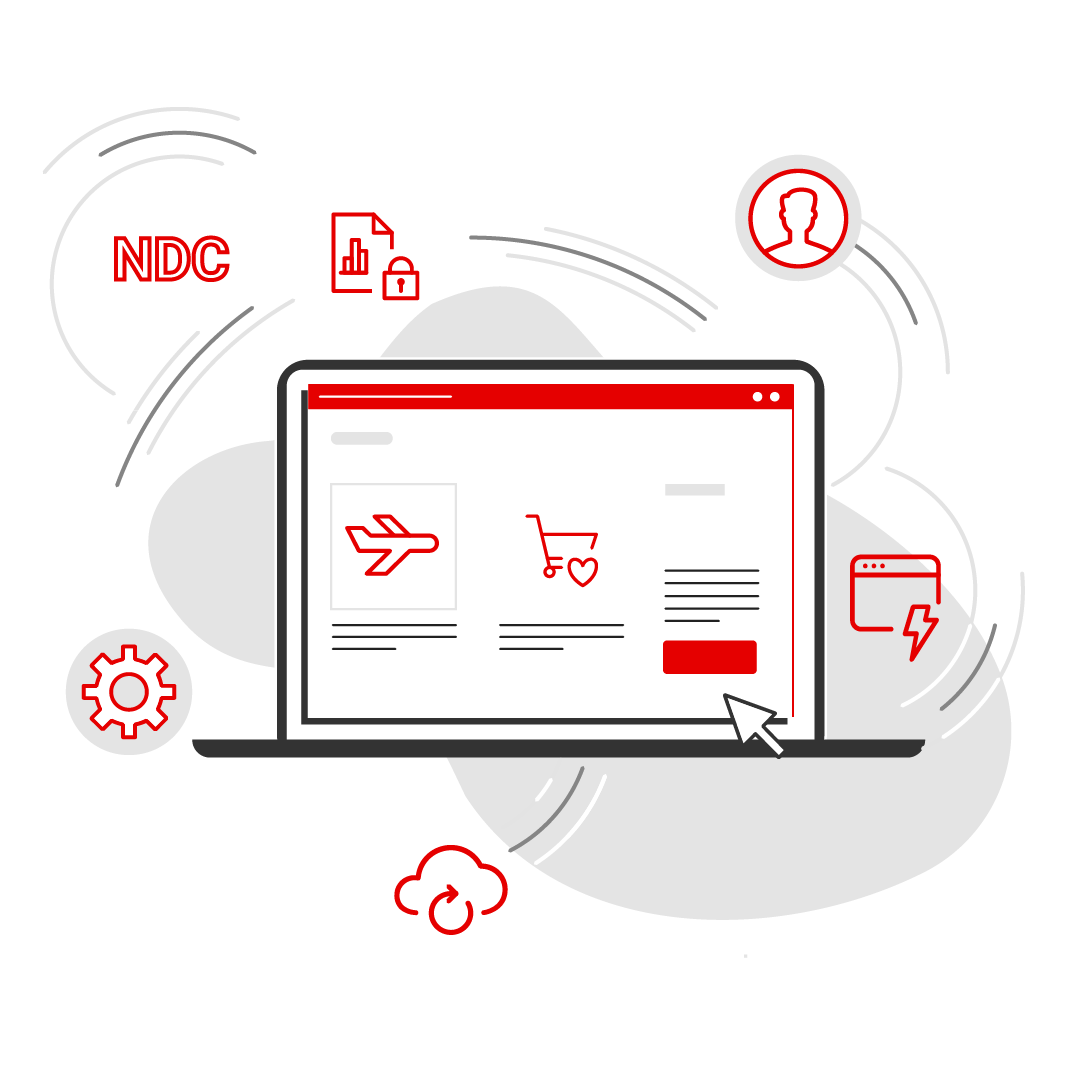
The transition to modern retailing is primarily a technological one: using NDC instead of EDIFACT and phasing out PNRs and EMDs in favor of ONE Order records. These standards introduce new data types and change the size, frequency and quantity of messages sent between systems. This has a knock-on effect on system latency, uptime, scalability and ultimately on customer experience.
To introduce tailored offers, airlines will also rely on more contextual information and customer data from the indirect channel. As traditional technologies are discontinued and new opportunities arise, agency leaders need to consider the technological implications on their systems and processes:
- The interdependence of internal and external systems across front, mid and back office
- Customer relationship management and data stewardship within agencies and between industry stakeholders
- Privacy, security and regulatory compliance for customer and booking data
- Data needs across marketing, accounting, reconciliation, duty of care and more
- The capabilities of marketing and customer relationship management tools
- AI/ML and data science opportunities and challenges
- Internal tech team capabilities and the mix of in-house bespoke software vs bought solutions
7. How can tech providers like Sabre help?
8. are airlines making progress.
Progress varies across the industry and some airlines have made more progress than others: dozens of airlines like Singapore Airlines and Qantas are working on NDC solutions as a stepping-stone towards modern retailing; some airlines like Finnair are going all-in with a plan to phase out EDIFACT distribution by 2025; and many airlines haven’t yet shared plans to adopt NDC.

Agency leaders can communicate directly with suppliers and leverage relationships with tech providers like Sabre to show and help accelerate progress. These are some of the considerations for discussions with suppliers:
- Availability of new and exclusive NDC offers
- Differences between NDC and existing ATPCO/EDIFACT content and capabilities
- Willingness to introduce or renew corporate negotiated offers
- Data and customer stewardship between suppliers, retailers and customers
- New benchmarks for success and service levels
- Potential changes to business reporting and reconciliation
9. The transition: how do we get there?
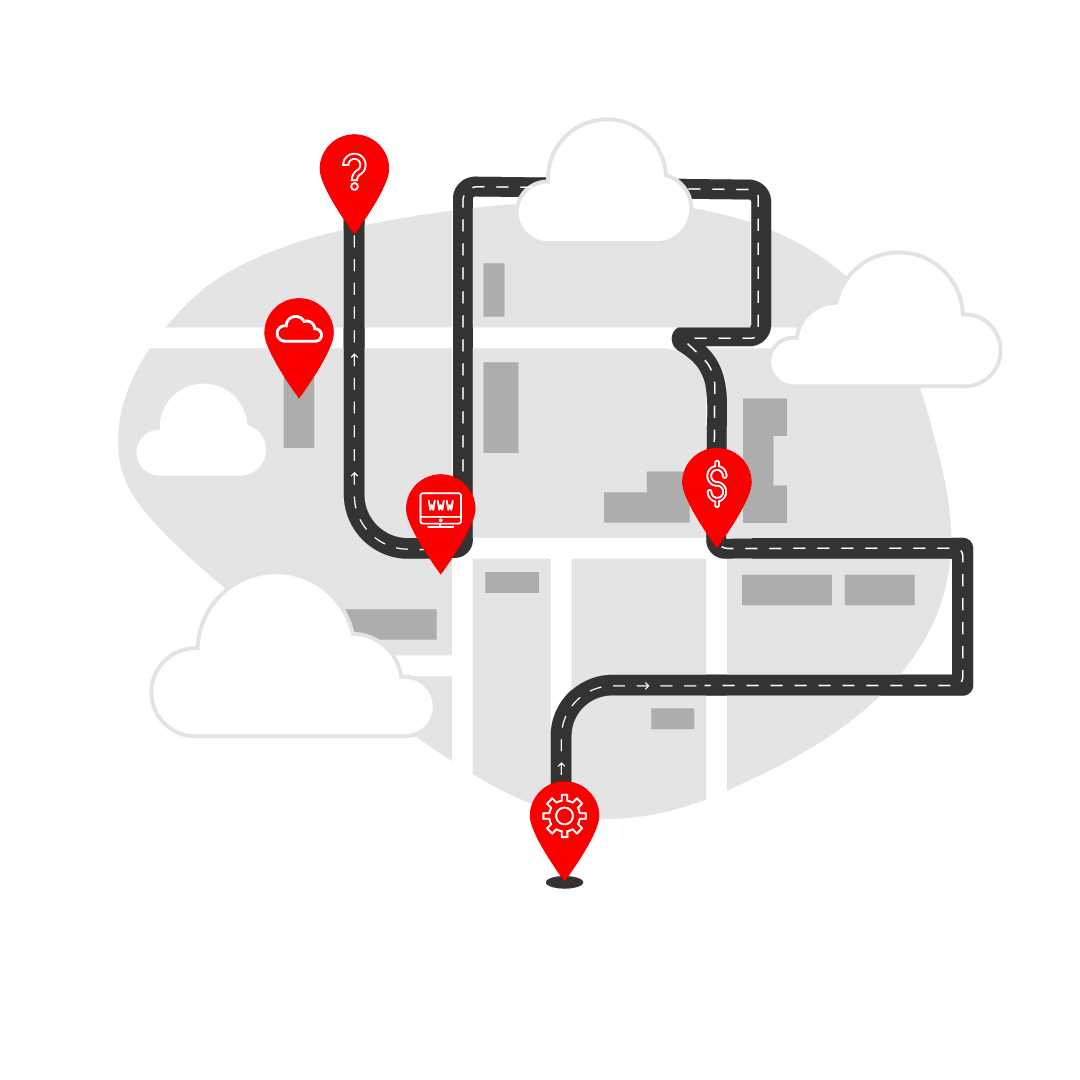
The travel industry is a complex web of stakeholders with different priorities. The transition to modern retailing is a long journey and we’ll undoubtedly face challenges and surprises along the way. IATA set 2030 as the target date for airline industry readiness, but there won’t be a big ‘switch on’ of new content and capabilities or a big ‘switch off’ of traditional technologies – we’ll operate in a world of multi-distribution workflows for many years.
Suppliers are building new solutions and they’re matching existing content and capabilities before experimenting with new ones. Tech providers like Sabre are expanding intelligent aggregation solutions to normalize content and workflows. Agencies have their own work to do on the strategic, operational, and technological considerations.
In the short term, we’re working on overcoming a few core challenges that impact agencies and the broader industry: multiple technical schema versions, shopping versus schedule-led workflows, and the technical performance of NDC-enabled systems. Additionally, 19 airlines currently make their NDC offers available to Sabre-connected agencies . By activating NDC capabilities from Sabre, you can maximize access to leading content with end-to-end workflow support, including servicing.
About the Author
Jonny Blackler is part of the Sabre team exploring what the future of travel will look like, what it means for travel agencies, and how agencies can transition their businesses to make the most of emerging technologies.
Take the conversation further with Sabre
As a global travel technology provider, we deeply understand the industry today, where we can go tomorrow, and the work needed to get us there.
Related Post

April 17, 2024
Tech Takeoff: paving the way for truly traveler-centric airline retailing
In today's dynamic airline landscape, where competition is fierce, margins slim and consumer choice abundant, airlines must prioritize the end-to-end traveler experience to not only survive but thrive.

April 2, 2024
Beyond NDC supports multi-passenger offers
The reason for booking a trip usually informs how many people will be involved. Corporate travel often includes one adult, while leisure trips typically involve multiple adults, or families with young children in tow. Sabre’s NDC...

April 1, 2024
Booking NDC content is easy in the Sabre GDS. Here’s why.
Looking for more detail? Check out our resources for getting started with NDC: Don’t miss out on NDC updates from Sabre! Subscribe to stay up to date on news and fresh resources.

February 26, 2024
Performing while transforming: Three ways to unlock revenue along the path to modern airline retailing
In recent months, there has been a noticeable shift in the industry conversation around airlines’ transition to offer- and order-enabled retailing, with questions like ‘if’, ‘why’ and ‘when’ being replaced by ‘how’. Many have already started...
September 25, 2023
Can your agency tech stack meet the demands of modern retailing?
Agency tech stacks will need to be updated to consume new data standards and process more data in new ways. Sabre supports leisure agencies, travel management companies, and online travel agencies to achieve modern retailing success...

August 31, 2023
Rethink your agency operations to achieve modern retailing success
Modern travel retailing, enabled by offers and orders and enhanced with AI/ML solutions, presents new ways for agencies to interact with customers. It also means new processes, increasingly fragmented content, shopping-led instead of schedule-led workflows, and...

July 27, 2023
What Top Gun can teach us about the future of airline retailing
Few movies have stood the test of time as well as Top Gun, and while I’ve let go of my childhood dreams of becoming a fighter pilot, I’m now focused on technological advancements in air travel...

July 25, 2023
Building a strategy for modern agency retailing success
Modern travel retailing, enabled by offers and orders and enhanced with AI/ML solutions, presents new ways for agencies to interact with customers. To capitalize on new opportunities and stay competitive, agency leaders should consider implications to...
Unsupported browser detected, for a better experience please upate to a newer version of Internet Explorer.
For the brave
The Future of Travel Retail Webinar
Where others see uncertainty, we see a world of possibility.
Times have changed. Radically so. Yet while other industries have pushed the boundaries of retailing innovation, travel stayed the same. Now, we want what they’ve got – and that demands huge transformation.
Watch our webinar about the future of travel retail and the monumental change that’s to come.
Listen to Jen Catto, CMO at Travelport, delving into the minds of travelers, to uncover why travel retailing is broken — and how it can be fixed —exclusively revealing the results of our retailing research.
Then find out from Travelport’s CPTO, Tom Kershaw, how we’re reinventing travel retailing and what we’re doing in Travelport to deliver on our vision for the future.
Finally hear from Sam Hilgendorf, CIO at Fox World Travel, about how they’re navigating the complex world of retailing and how Travelport is helping them on their journey.
The Future of Travel Retail
Webinar recordings are also available in other languages: German , Italian , Japanese , Spanish
Want to learn more about modern retailing? Visit our ‘The Future of Travel Retail’ hub and learn from experts across all industries.
New Strategy Guide: Why the Future of Airline Retailing Is Open

Sabre + Skift
October 26th, 2022 at 10:00 AM EDT
Airlines of all sizes are looking for smarter and more efficient ways to sell more products and services. A new strategy guide by Sabre explores how moving toward an offer and order retailing model will help them achieve this goal while maximizing revenue, operating with more agility, and improving customer satisfaction.
This sponsored content was created in collaboration with a Skift partner.
Airlines are struggling to maximize revenue amidst unprecedented change, including flight delays and cancellations, understaffed airports, pent-up demand, and a growing sense that unpredictability in the marketplace is here to stay. To stay ahead of the game, both full-service and low-cost carriers are looking to sell new products in new ways.
But meeting this challenge isn’t easy without a strong technology partner to enable broader digital transformation. Legacy systems are limited in their ability to deliver against the expectations of today’s travelers, who want a higher level of personalization, richer content, greater transparency, and convenient payment methods.
Advanced retailing capabilities powered by offers and orders promise to enable airlines to enhance the traveler experience and generate more revenue opportunities, with the ability to tailor offers across multiple channels.
“We’re actively building a retail travel marketplace that intelligently enables airlines to dynamically retail and distribute a broad choice of tailored offers across any channel,” said Mike Reyes, vice president of product management at Sabre. “Orders can be fulfilled and delivered with ease on an open, flexible, and cloud-native platform, resulting in value creation for the airline at each step in the process.”
Sabre’s new strategy guide, “The Future is Open: A Smarter Approach to Airline Retailing”, offers a comprehensive breakdown of the advanced retailing capabilities enabled by the transition to an offer and order model.
For full-service carriers, this transition may take more time and necessitate an extended period where legacy systems and new systems need to co-exist. For many low-cost carriers, which may already have advanced retailing capabilities, the focus could be on transitioning to scalable technology that extends their existing capabilities through partnerships, access to third-party content, or other modular elements.
“There’s no one-size-fits-all approach to transition, and I believe how airlines transition to a retail-powered future is equally as important as the end-state itself,” said Greg Gilchrist, senior vice president of global sales at Sabre. “We’ll stand shoulder-to-shoulder with our airline partners throughout the process, turning unknowns into knowns along the path to our shared goal of modern travel retailing.”
In this report, you’ll find:
- A vision for enabling airlines to become advanced digital retailers, all while improving customer satisfaction, creating new sources of revenue, and optimizing existing sources
- A deep dive into why Sabre’s strategy for offers and orders is built on choice, intelligence, and ease
- How airlines can evolve beyond traditional product models and sell a wider variety of travel-related products and services
- How an offer and order strategy benefits both full-service carriers and low-cost carriers
- An overview of the design and technology behind Sabre’s cloud-native infrastructure
For more information about Sabre’s journey toward travel retailing modernization, visit Sabre.com/open .
This content was created collaboratively by Sabre and Skift’s branded content studio, SkiftX .
Have a confidential tip for Skift? Get in touch
Tags: airline retail , airlines , retail , revenue , revenue management , revenue strategy , sabre , SkiftX Showcase: Aviation
The Future of Travel Retailing
Click the button to download the report.

As modern retailers, some people view the travel industry as a laggard, relatively unchanged over the past decade while other mass consumer industries such as video, music, telecom and media have been completely transformed, primarily by technology. The travel industry, however, has not been stagnant and is slowly responding to the consumer pressures and expectations that are forcing innovation. This report - created in cooperation with Sabre - seeks to highlight the opportunities and challenges within the industry, and how technological innovations can help drive collaboration to break down barriers and bring about transformation. To gain perspective on the current and future state of travel retailing, Phocuswright conducted in-depth interviews with more than a dozen senior executives representing various industry segments including airlines, hotels, leisure and travel management company agencies, and online travel agencies. These industry leaders discussed the developments and innovations they saw in travel retailing, the technological solutions enabling these developments, how data and its application factor into these solutions, how travel industry retailing compares to other industries' retailing innovations and solutions, and the challenges and opportunities travel-specific solutions present.
What is Open Access
An Open Access subscription provides company-wide access to the whole library of Phocuswright’s travel research and data visualization.
Curious? Contact our team to learn more:
What is open access+.
With Open Access+, your company gets access to Phocuswright's full travel research library and data visualization PLUS Special Project deliverables.
Provide your information and we'll contact you:
Curious contact our team to learn more:, free download registration.

The path forward for the US retail industry
Today, months after COVID-19 first hit US shores, it’s increasingly clear that most retailers won’t be able to rely on their old strategies and business models to compete effectively in the next normal. In this episode of the McKinsey on Consumer and Retail podcast, McKinsey’s Steven Begley, Becca Coggins, and Steve Noble consider how the US retail landscape has changed and what companies must do to thrive in the postpandemic world. An edited version of their conversation with McKinsey Global Publishing’s Monica Toriello follows. Subscribe to the podcast .
Monica Toriello: Hello, and thanks for joining us today. We’re now three-quarters of the way through the year 2020, and it’s been a year like no other for people and businesses all over the world. In this episode, we’ll talk about one of the industries most greatly affected by the pandemic: the retail industry. We’ll focus today’s discussion on the US retail sector, but many of the lessons and imperatives we’ll discuss apply to retailers all around the world.
Joining us to share their perspectives are three McKinsey partners who have worked extensively with retailers from every subsector, including grocery, restaurant, and fashion. They’ve each written several articles on the retail sector, which you can find on McKinsey.com. Recently, the three of them coauthored an article titled, “ The next normal in retail: Charting a path forward .” Let’s meet our guests. First, we have Steven Begley, a partner in McKinsey’s New Jersey office. Also joining us is Becca Coggins, a senior partner based in the Chicago office and a longtime leader of McKinsey’s global Retail Practice. And finally, Steve Noble is a senior partner in Minneapolis who coleads McKinsey’s global work in retail transformation.
To start, I’d like to ask each of you for a short answer to my first question. One of the things that McKinsey has been tracking and that you’ve all been writing about is the shifts in consumer behavior , which have become evident over the past few months. What’s one way that your own shopping behavior has changed during this pandemic?
Becca Coggins: Monica, I might sound like a cliché. My shopping was already very heavily online. It has accelerated that way, but, like many Americans , what I buy has shifted a fair bit. I’m a bit of an apparel junkie, but that’s taken a backseat to new hobbies, new things for the home, and things to keep the kids engaged around the house.
Steven Begley: My grocery experience has gone completely digital. And my grocery experience has actually accelerated. I live in Manhattan, and I didn’t frequent grocery stores prior to the pandemic, but now I’m constantly purchasing groceries, and I only do it online. So it’s a different experience for me.
Steve Noble: I’ll break the rule of one thing, but I’ll be brief. One, my front porch looks like a warehouse full of boxes each day, so lots of online shopping. I no longer buy pants; I buy a lot more wine instead.
The migration to e-commerce
Monica Toriello: You’ve all brought up the migration to e-commerce, which has been one of the biggest and most obvious shifts during this period. What has worked there, and what hasn’t worked? In other words, as consumers have shifted more of their spending online, what are retailers getting right? And what are they still getting wrong?
Steve Noble: I’ve been impressed with how quickly retailers have adapted to this new way consumers are shopping—ramping up online and curbside delivery. I live in Minneapolis; Hy-Vee is one of the local grocers, and they’ve always had a curbside drive-through pickup. But that capability, as you might imagine, was quickly overwhelmed. While it wasn’t pretty, I was impressed with how quickly they mobilized to create more scale. They basically cordoned off a section of the parking lot and set it up with refrigerated shipping containers. You place the order online, and you give them an indication of when you’ll be coming. They don’t give you a slot; rather, you give them a slot. You pull up, they load the groceries in the back of your vehicle, and you drive off.
It was a great experience, and I appreciated how quickly they adapted. I imagine that over time they will reimagine the look and feel of that experience. Because things, in many cases, were stood up so quickly, they weren’t done initially with, “How do you create a great customer experience ?” They were done with just, “How do you get the bare minimum in place?” Now there’s an opportunity to continue to think about how to make some of those delivery or fulfillment models better, more sustainable, and more enduring customer experiences.
Becca Coggins: It almost makes me think we’re in the foothills of what omnichannel-driven convenience will look like—and that there’ll be some big innovations that scale now that consumer expectations have been reset. That’s where we’ll start to see some more innovative models and some more interesting partnerships—as players try to think about new ways to meet those needs.
If you look at how many more consumers are using e-commerce—such as using curbside pickup and buying online and picking up in store—most of them like it and plan to stick with it after the pandemic. So you have the consumer need. And retailers have done a good job of standing up things, as Steve said, to be able to meet that need. The next challenge is figuring out how to do it as a more seamless experience—in a way that’s not temporary but that meets these emerging needs around convenience and speed, especially.
Subscribe to the McKinsey on Consumer and Retail podcast
A ‘shock to loyalty’.
Monica Toriello: Becca, you mentioned that consumers plan to stick with behaviors they tried for the first time during the pandemic and that they liked. Another shift you describe in your article is the “shock to loyalty”—a greater willingness among consumers to switch brands and retailers. As you say in your article, “The beneficiaries of this shift include big brands, which are seeing 50 percent growth during the crisis,” and private labels. “Some 80 percent of consumers who started buying private-label products during the pandemic indicate that they intend to continue doing so even after the COVID-19 crisis subsides.” A couple of questions about that. First, should we believe consumers? Will they indeed stick with big brands and private labels postpandemic? And what are the implications for retailers?
Becca Coggins: What’s interesting to us about this phenomenon is that it’s not just brand switches, it’s not just retail switches, it’s not just channel switches. It’s all of the above—to the point where three out of four Americans will change something meaningful about the way they shop, including relationships that were previously sticky and stable, like with your neighborhood grocery store, for example. Some of the examples you cited, Monica, are some of the ones that stick out. We expect these could still be dynamic—but on private label, for example, it’s a bit unsurprising, given that consumers are focused on value, and they’re buying more categories that are in essential consumption categories.
While some of these shocks to loyalty, whether it’s the shift to larger brands or the one to private labels, started out of sheer availability—“I went to the store and didn’t see the brand I typically buy, so I bought the alternative”—the reasons for the shift have started to evolve to reflect much more the shift around value and, on the retail side, where to actually get that omnichannel convenience you’re looking for. So now it’s all three of those things: availability, value, and convenience. We do tend to believe consumers. The private-label switch, for example, we’ve seen in prior recessionary periods pick up at about the same clip. Overall, the level of switching is something we haven’t seen in this era, so probably it could moderate some. But consumers are satisfied , and they’re continuing to shift some of those things.
The implications for retail are along the same lines of why consumers are switching. Are you providing available products, particularly in essential categories that are at the top of consumers’ shopping lists? Are you providing everyday value? And are you providing the type of convenience that balances consumers’ ability to get it when they need it but also in the mode that they want it—without having to navigate big crowded stores, et cetera? I think the implications are, very simply, how fast retailers can adapt to the new consumer reality, which is more focused on value and convenience than even before the COVID-19 crisis.
Monica Toriello: The migration to e-commerce is happening at the same time as another one of the shifts that you’ve just pointed out, which is a focus on essentials and value. Talk about what that means for omnichannel pricing. Steven, in an article you wrote in February, before the pandemic, you observed that, at least in grocery, some retailers had online price-matching policies , whereas others didn’t: they had different prices online and in store. At the time, you said that the jury was out on which is the right approach. What’s your latest thinking on pricing?
Steven Begley: What we’re seeing is that retailers have had an opportunity to pull back on promotions as a result of the last couple of months because of the increased demand; consumers’ willingness to pay has been a lot higher. Fundamentally what we’re seeing, though, is at the end of the day, pricing is one of the top value drivers for why a consumer selects one retailer over another. Pricing will continue to be a core differentiator, a core pillar, in retailers’ strategies going forward. We’ll continue to see retailers experiment with the interplay between online versus offline pricing. But one thing we’re pretty confident about is that price matching will continue to be something that most or all retailers do.
Going beyond incremental thinking
Monica Toriello: Let’s talk about things that all retailers should do. In the article that the three of you coauthored, you name five critical areas for the next normal: revenue management, operating model, digital capabilities, capital investments, and M&A and partnerships. Those cover a lot of ground. Instead of elaborating on all five, I’d like each of you to pick one that you think retailers aren’t paying enough attention to or somehow not adequately addressing. Out of those five, which one are retailers neglecting or overlooking?
Steve Noble: I’ll start with revenue management. And I’d start with a perspective rooted in the financial crisis of 2008 and 2009. When we studied that crisis, we looked at what allowed some retailers to be resilient and come through relatively strongly. One of the big drivers of resiliency and success through that period of disruption and crisis was, “Did you focus sufficiently on driving the top line and on the consumer in your business?”
Many retailers had the reaction, “We need to look first, second, and third at cost and take out every bit of cost we can, given the pressure on our business.” The retailers that were most successful certainly thought about cost—but they thought much more about, “How do we make sure we’re delivering a great customer experience? How do we make sure we’re driving the top line? How do we think through our pricing, our assortment, and our frontline sales model to deliver a great customer experience in the spirit of taking share?” If you then fast-forward to where we are today, much of the same will apply.
We’re not saying, don’t think about or take out costs where it’s prudent. But our belief is that retailers that will come through this the most successfully are those that are thinking about all the potential revenue levers to drive their business and outcompete those they are positioned against. We of course know that some parts of retail are experiencing record growth and others are experiencing record decline, so this is not to say that everyone should be growing robustly. But it is a real time to outplay and go on the offensive relative to your competitive set—an approach that we believe will allow you to come out of this in a much better place in the long term.
Steven Begley: Monica, I’d say the five areas that we wrote about do cover, as you pointed out, a broad swath of capabilities across any retailer’s business. Now is a great time to put everything on the table and rethink it from the perspective of transformation—whether it’s finally pivoting your merchandising organization to be omnichannel and tech enabled or personalizing your customer experience to a level you’ve never seen before. Now is a good time to release those old constraints and prepare for the next normal.
That said, on the M&A point in particular, we tend to see a lot of M&A and partnership activity anytime an industry is disrupted, and we’re certainly in one of those times right now. We expect to see a lot of the traditional consolidation plays that you typically see: optimizing for COGS [cost of goods sold] and SG&A [selling, general, and administrative] opportunities. But there’s also a real uptick in channel expansion and making M&A or partnership plays that allow retailers to buy into new capabilities.
A good example of this would be in the fulfillment value chain. It’ll be much easier and much more practical for folks to buy into some of these technologies—like microfulfillment, for example—versus trying to build them themselves. The same argument could be made for commercial analytics. For a lot of these advanced analytics algorithms that drive pricing and promotional decisions, it’s going to be much easier and much more efficient from a capital standpoint to buy these capabilities and embed them in the organization versus trying to build them from scratch. I do think we’ll see quite a bit of M&A and partnership activity, particularly on the capability-building front.
Becca Coggins: There is some good news, actually, on operating model, and I would start there. Many executives we talked to are, frankly, pleasantly surprised at how quickly and effectively their companies were able to pivot in the face of the biggest exogenous shock most of us will have seen in our careers. One of the examples I find inspiring is Best Buy. They stood up curbside pickup, when all of their stores were closed, in 48 hours nationwide. That process, for a retailer of that size and scale, would typically take several months of piloting to stand up and get the kinks out. But they had a high-quality, effective, customer-friendly solution available in a weekend.
The challenge side of that, and a place we think retailers need to be focused and introspective, is how to redesign the operating model to sustainably deliver these types of outcomes. That’s true for speed, it’s true for efficiency, and it’s likely true for ensuring that the operating model is delivering on what we’ve already described as new or accelerated consumer preferences and behaviors. Have you sustainably redesigned for speed and for omnichannel and for efficiency so you can deliver the best value to your customers?
Steve Noble: I might just add a broader point that sits a level above the five specific topics we’re talking about. In retail, prior to six months ago, the mindset of most retail executives would be, “if I have a business that’s growing at a 2 percent same-store comp rate, and I can get that to 3 percent, I’m feeling pretty good. If my margin is 4.5 percent, and I can get that to 5 percent, I’m feeling pretty good.” The notion of the industry is that it’s a low-growth, low-margin business in general. That tends to foster incremental-type thinking: “I don’t need to get a big bump to actually feel pretty good about my performance.”
If you look at where things are now, what may have been a 2 percent or 3 percent comp-growth business is now up 20 percent or maybe down 20 percent. Likewise, margins are up and down dramatically. It is a good forcing function to break the mold of incremental thinking and rethink more fundamentally how you want to reach your customer. From stores versus online versus combined channels, how do you want to think about technology as a way to reimagine the customer experience and the labor and service model that you might be delivering? The amount of disruption happening right now does create some space to think pretty big and bold in a way that just wasn’t quite as typical of retail historically.
The battle for talent
Monica Toriello: These areas that you’ve described all sound like they require new capabilities, especially in tech and digital and analytics—which leads me to a question about talent. Steven, again, in your February article, you say, “Digital talent may be the single-most-important determinant of a company’s likelihood to succeed in the grocery market in the next few years.” And that’s probably even truer now, right? You had offered up some steps for retailers to take, such as hiring a chief digital officer, rethinking location strategies, and looking beyond brand-name universities. But can you talk about the battle for talent today and what retailers can do to become attractive employers for the kinds of talent they need?
Steven Begley: The battle for talent is real. And retail is not necessarily a sector that folks coming from data-science backgrounds and technology backgrounds would gravitate toward first. That said, we’re seeing the disruption play out in a space where we’re at just the beginning of the acceleration of many of the trends that we’ve talked about, so in terms of a sector that is primed for impact, retail is potentially the biggest one out there. What that means for retailers is, they need to be out in front of these populations of technologists and data scientists and statisticians and others, making the case for why retail is such an exciting place to be right now. I think all of us on this podcast would agree that it is.
We’ve seen a number of retailers shifting their digital businesses to more urban environments, trying to change their formats, and even changing the physical look and feel of their office structures to attract this type of talent. I think we’ll see more of that and a continued pitch to the industry, so to speak, on why retail is such a great place to be.
Becca Coggins: Now is the time for retailers to get aggressive about winning the war for this talent. We’re seeing, and will continue to see, a displacement of digital talent and analytics talent, certainly within the industry, where there’s been momentum versus decline, but also within adjacent industries. You can imagine a pretty big influx of talent—analytical talent, especially—from sectors like travel and hospitality into retail, as well as across different subsectors of retail.
Steve Noble: I agree. The war for talent is real, and now is an important time to play it aggressively. It begs the question, what allows one retailer to differentiate itself from the next in terms of winning that war? Certainly, part of it is whether they are investing in things that are exciting, et cetera. But maybe more than ever, there’s also a chance to see what a company’s “DNA” is and what its values are.
The nature of the crisis we’re in allows you to understand what different retailers think about caring for their people from a health-and-safety point of view. What do they think about creating flexibility for a workforce that may have kids schooling from home or family members who need to be cared for at home? What do they think about diversity and inclusion ? There are a lot of different markers that we’re seeing more acutely now that allow you to stare into the soul of the company a little bit. That will be probably as big a marker of which businesses win the war for talent as job descriptions and capabilities being built. Not to say those aren’t important, but I do think the balance between those is probably different than it was six months ago as well.
Becca Coggins: Interestingly, customers are starting to pay a lot more attention to those same attributes: how a company treats its employees, what kind of diversity and inclusion policies they have, and how that shows up to the market. We’ll start to see the whole ecosystem focus more on those things.
Steven Begley: One industry-wide example is that Eightfold AI and FMI, an industry association, came together to create something called the “Talent Exchange,” which we supported. It essentially matched retailers that had employees who needed jobs with those that had opportunities for them. And when the COVID-19 crisis first hit in March and early April, it was impressive to see the speed at which those organizations came together to create the Talent Exchange and the speed at which retailers signed up to become a part of it. Companies like Macy’s, Walmart, and United Airlines quickly came to the table to put opportunities into the exchange and also to create opportunities on the exchange. I thought that was a great example of the industry coming together quickly to do something good for the community.
Monica Toriello: It’s been a tough year for many retailers, and it could be a long road to recovery. Last question: If a retail CEO says to you, “I want my company to thrive in the next normal. Give me your single-most-important piece of advice,” what would you say?
Steven Begley: Chart out what your customers’ demands are going to be three years from now, five years from now. Create that vision, get your organization aligned on it, and work back from there to figure out the costs, the implications, and the investments you need to make. Focus on who that customer is going to be, and plan from there.
Becca Coggins: I think the same thing. Follow the customer. Understand what you can do distinctively for them, and orient your business to be able to do that.
Steve Noble: Given the uncertainty and volatility in retail, you need to plan in short cycles: what’s going to happen next week, next month, next quarter. But don’t forget to also plan for two or three years out. How does your business look fundamentally different on the backside of this than it did prior to the pandemic, or even now? So it’s that balance of being agile in the short term but also putting real thought into what comes out on the back end so you don’t end up with an answer two years from now that’s the amalgamation of a set of small choices. Instead, it’s an intentional view of creating a much better and different business.
Monica Toriello: Great advice. Thanks for spending time with us today, and thanks to all our listeners. Join us again in a few weeks for the next episode of the McKinsey on Consumer and Retail podcast .
Steven Begley is a partner in McKinsey’s New Jersey office, Becca Coggins is a senior partner in the Chicago office, and Steve Noble is a senior partner in the Minneapolis office. Monica Toriello , a member of McKinsey Global Publishing, is based in the New York office.
Explore a career with us
Related articles.

The next normal in retail: Charting a path forward

The next normal: Retail M&A and partnerships after COVID-19
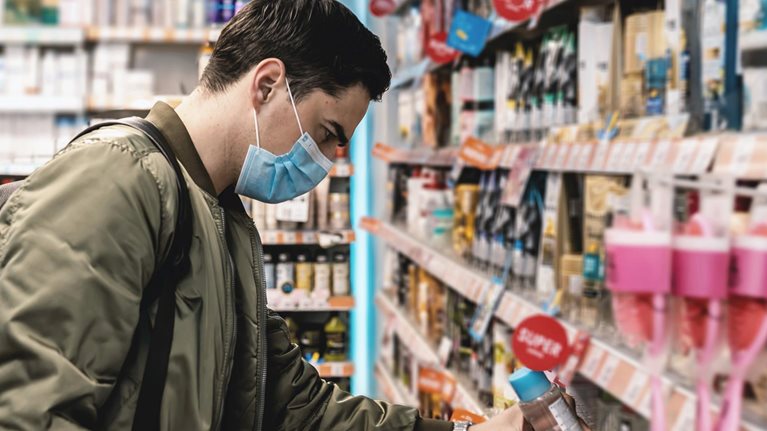
What matters now in the consumer sector
- +44 (0)20 7183 3785
- [email protected]
11 inspiring ideas for the future of travel retail
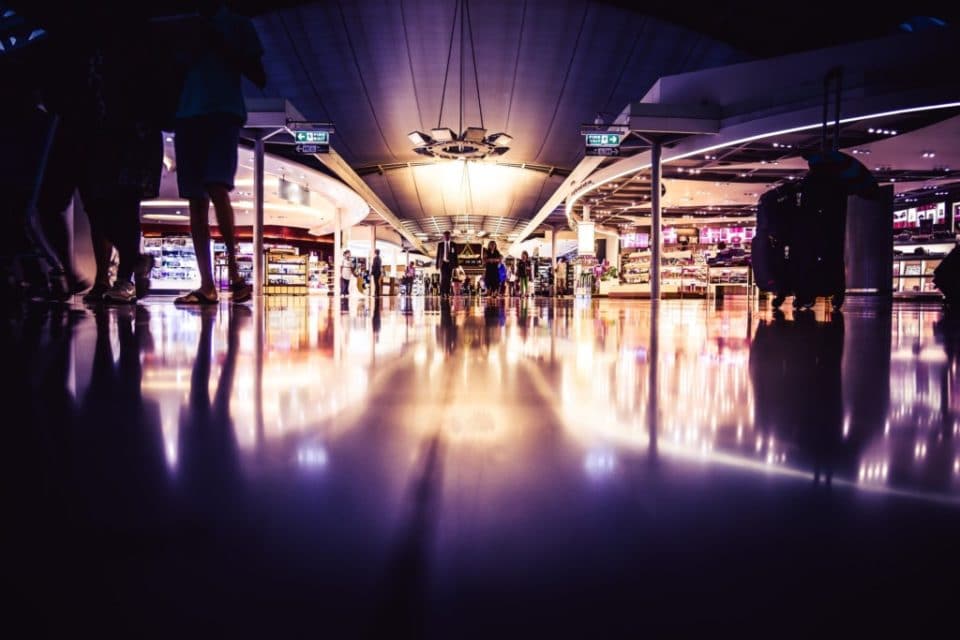
Boom. That’s the sound of the travel retail sector blowing up as brands double-down on their efforts.
It’s not surprising as the sector will be worth $125 billion by 2023 according to Allied Market Research. But it’s also one that’s full of challenges.
One is time. The requirements of air travel – security, passport control, gate closure – eat into the time that customers spend at the airport, even if they’re there several hours in advance. Their shopping habits are guided by the airport timetable as it funnels them through the space.
Nigel Dolby Consulting reported that in 2013 the average amount of time spent in an airport globally was 150 minutes. By 2016 this had dropped to 133 minutes.
Of this, the average shopping time was 29 minutes. That’s not a lot of time to draw someone in and it’s certainly not got much wiggle room for masses of browsing and exploring.
Another issue is space. Most travel retail stores, counters and pop-ups are operating in a restricted amount of space. That can make it difficult to balance merchandising and experience.
Of course, an ongoing issue is around baggage allowances and product restrictions. Sometimes customers just don’t have the ability to carry everything they might like to buy, which makes for difficult choices.
These, and other externally-set challenges, can make it seem harder to innovate in travel retail. But there are ways to overcome these constraints to create better buying experiences.
Here are 11 recent inspiring ideas that show how travel retail is moving into the future.
And if you’re interested in finding out more about what’s happening in travel retail, Insider Trends delivers future of travel retail presentations .
1. Free Kit-Kat’s for delayed customers
Earlier this year, Sao Paolo airport debuted a special vending machine that aimed to take the sting out of flight delays. For obvious reasons these are one of the most frustrating parts of air travel. With Nestle’s vending machine customers could scan their boarding pass and if it registered their flight was delayed, it dispensed a free Kit-Kat to ease their woes. It’s a cute spin on Kit-Kat’s ‘Have a Break’ slogan and it makes people think of the brand in a positive way (as compared to the airport that they’re probably raging at). After all, who doesn’t like free chocolate?!
2. Heathrow Airport personal shoppers
This was also the year that Heathrow Airport unveiled its new Personal Shopper Lounge in Terminal 3. It extends the airport’s existing complimentary personal shopping service, which allows customers to book a session with an accredited stylist before they travel. The stylist then contacts them in advance to discuss what they’re looking for, their budget and time available to shop. This is used to create a personal shopping plan and choice of outfits to try to maximise the available time.
Of course, the service comes with the luxury touches that you might expect, but it’s a great way to help customers with the challenges of choice and time. If an airport doesn’t already have a personal shopping option it’s a top-of-the-list idea to try.
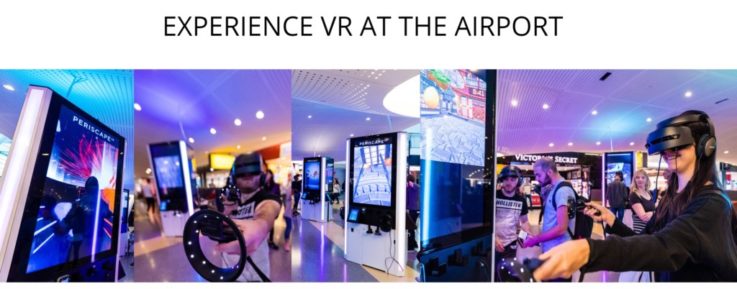
Image credit: PeriscapeVR
3. JFK Airport AR/VR experiences
One of the things that comes with air travel is time spent waiting around in airports. To try and make something of this dead time, JFK Airport in New York City has launched a new six-month VR experience centre. Created together with PeriscapeVR, the hub has 12 VR stations where customers pay $1-2 a minute to access curated VR content. The experiences last 5-10 minutes and range from whale encounters to exploring imaginary worlds in space. It’s great to see travel retail embracing these new technologies to try and improve the customer experience. There’s lots of scope for VR and AR to be incorporated and we’re sure it’ll be a key feature in the future.
4. TripAdvisor’s Travel Retail Stores
Anyone in the travel industry, or who has ever been on a trip, should be familiar with the TripAdvisor name. The online review and booking site has been branching out into physical retail, and this year opened two travel essential stores at the George Bush Intercontinental Airport and the Phoenix Sky Harbor International Airport in the US.
While the stores offer key travel items like plug adaptors, the interesting thing about them is the large interactive screen that lets travellers find out more about the local area. The screen serves up TripAdvisor reviews and customer photos about hotels, attractions, restaurants and more in the area.
This is a neat idea. Whether travelling for business or pleasure, most of us need some guidance on where to stay and what to do when we go away. And yes, we can all access this information on our smartphones, but maybe you’ve just landed, and you don’t have your phone configured for where you are yet. Plus, there’s a great opportunity to have knowledgeable locals staffing the place who can talk customers through the results and help them narrow down the best things for them.
5. Bombay Sapphire Glasshouse
Taking its cues from the Bombay Sapphire installation in Schiphol airport last year, a new branded pop-up from the gin giant appeared in both Schiphol and Auckland airport earlier this year. Its striking design was based on the Thomas Heatherwick glasshouses at the Bombay Sapphire manufacturing site in England.
In keeping with this, when customers entered the space they could hear the sounds of birds and running water. The pop-up tickled the other senses as well with customers about to try their perfect G&T and smell the different gin flavours in scented vapour droplets in the air. We loved it because of its out-of-the-ordinary look and multisensory features which make for a moment of calm among a busy airport. And this is exactly what a lot of customers want.
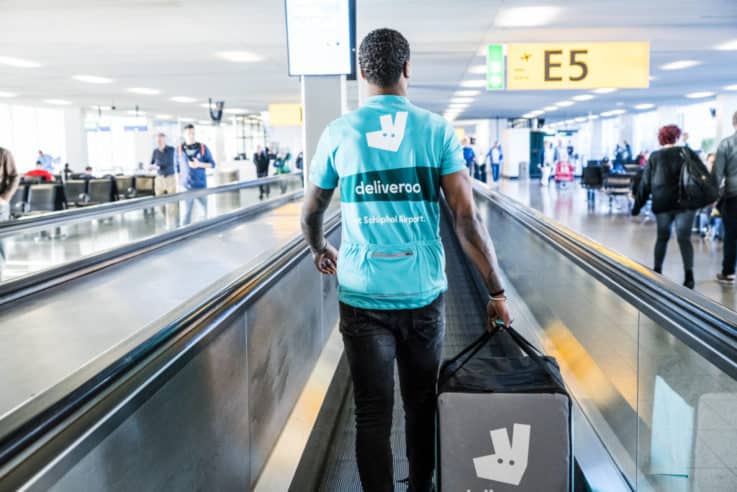
Image credit: Schiphol Airport
6. Deliveroo at Schiphol airport
Deliveroo is one of several companies that have taken the take-away food idea and extended it to everyone’s favourite food brands from Nando’s to McDonald’s. Earlier this year, it brought its food delivery service to the airport in a pilot with Schiphol and HMSHost International. During this time customers flying from Pier E could use their smartphone to order food and drink to be delivered to their gate within 15 minutes.
What we love is that this concept has recognised that customers have to spend a large amount of time at their gate, but catering options may be limited. Making more of gate time seems like a great opportunity for travel retail whether it’s a Deliveroo-style service that delivers other products to them, or the ability to browse and order their in-flight duty free in advance.
7. Lotte Duty Free VIP membership
South Korea’s Lotte Duty Free has beefed up its VIP membership programme this year. First up, it opened the Star Lounge in April – a private space for VIP guests with free refreshments and the ability to preview duty free goods. It also has a personal shopping service.
Following on from that, Lotte Duty Free also overhauled its VIP programme to offer more benefits to members. In the past a customer’s level of membership gave them discounts, but now the scheme lets them enjoy a range of benefits in their preferred category of beauty, food or travel. The programme works with various partners to deliver the rewards.
Loyalty is changing and increasingly memberships are seen as being a more valuable option. At the same time, Lotte Duty Free is making sure that customers want to be members by offering them services and rewards that are useful to them – and with some personalisation.
8. VIMO WeChat payment
One challenge for travel retail is helping customers shop and pay in a way that is convenient for them while they are away from home. One fix for this is Vietnam mobile payment platform VIMO’s partnership with SASCO which lets Chinese shoppers use WeChat to pay for their duty-free shopping at airports across Vietnam.
Introduced in January, the system lets Chinese tourists visiting Vietnam use their WeChat mobile application to scan a QR code generated at the checkout to pay without the need for cash or credit cards. WeChat is huge in China, so it makes a lot of sense to add it as a payment option within airports. It makes it more convenient for these travellers, which hopefully means they’ll buy more, but also it just feels obvious. We’re now using a huge variety of payment options from Apple Pay to cash, and the more travel retail can cater for these the better.

Image credit: Shiseido
9. Shiseido NARS Lip Gallery
Screens are a common sight in travel retail, but not always in the most effective implementations. We loved what Shiseido did with its NARS Lip Gallery pop-up at Bangkok’s King Power Rangnam duty free space. Its installation used AR and gamification to let customers try on tonnes of NARS lip products, without having to physically try them on. The Digital Lip Wall also let them interact with colour shades and share on social media.
It’s not the only digitally-powered beauty activation in travel retail, there have been a few recently, but it’s a good case study. AR in particular seems to be a super-useful technology for beauty travel retail because it allows you to try on multiple products and colours without having to have them physically put on your face and taken off again. Given how short someone’s time might be before their flight this tech could be hugely valuable in getting them over the line to buy.
10. Moët Hennessy’s multisensory pop-up
There are a lot of things assaulting the senses in an airport – the crowds, the endless announcements, the bright lights – so it’s surprising that travel retail doesn’t traditionally do more to counteract this. Moët Hennessy’s pop-up at the Charles de Gaulle airport is one example that draws customers in through their senses.
Designed to promote the travel exclusive James Hennessy cognac, the obvious offering was product tastings. But the product was also sold via smell, with the pop-up home to ceramic plates infused with some of the scents within the cognac. The space also hosted visual storytelling about the namesake 18th century explorer and entrepreneur, which helps create a backstory and sense of heritage for the product.
Storytelling can be lacking or simplistic in travel retail, but this is a great example of how powerful it can be in creating links to a product before you even buy it.
11. Lego Store Passport
Ok so this one isn’t so new, but it screams great idea for travel retail so we’re including it. Customers who visit certain Lego Stores around the world can get a free passport which they can use to collect stamps from the Lego Stores they visit. Much like how we used to collect stamps from airports in our real passports.
The passports themselves are cute, with stickers for owners to customise them with, but they are also a great reason to seek out Lego Stores when travelling. We love the collector vibe and there’s so much scope for international travel brands to do a similar thing with their airport stores ensuring that customers always visit them when they travel.
What does this say about the future of travel retail?
In many respects, the trends in travel retail are the same as physical retail with experience being front-and-centre. Travellers want more interesting, more immersive and more valuable experiences, whether that’s information and guidance based or a multisensory pop-up. The unexpected, like Kit-Kat’s vending machine, is also a great way to drive engagement, and provide a burst of interaction and fun. As shoppers we all want to see something new – even when we’re travelling.
There’s also still a big space for travel retail to take advantage of dead time like waiting at gates to create opportunities to buy, or to use services like personal shopping to help travellers make the most of their limited time. New digital technologies like VR and AR are also making an impact in providing a way to circumvent some of the time and effort challenges of beauty retail in a travel environment.
At the end of the day we travel to go to different places and experience new things – and this is what travel retail should keep in mind.
Want all our insider insights into the future of travel retail? You’re in luck – Insider Trends offers future of travel retail presentations tailored to your business. Book yours now.
Related Articles
Below are other articles from our blog that cover similar topics:
Why it’s time retail started measuring experience in-store

The Best New Retail in London – April 2024
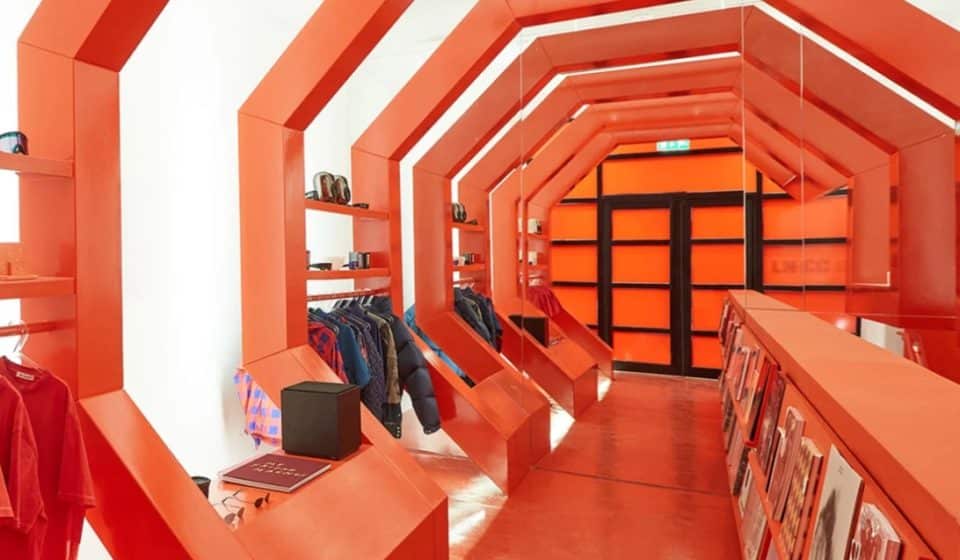
The Best New Retail in Japan – November 2023
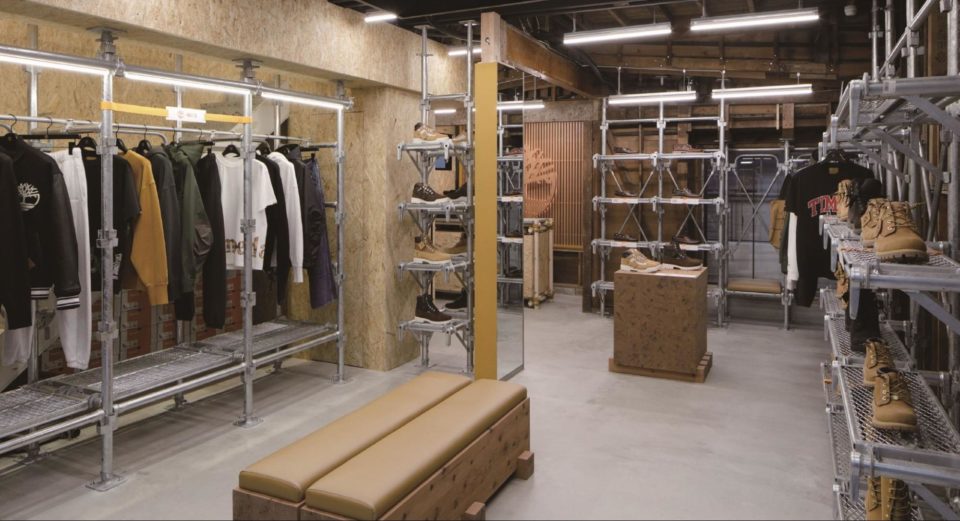
HORIZONTV FEATURING BD+C : WATCH EPISODES ON DEMAND AT HORIZONTV
Currently Reading
The future of travel retail.
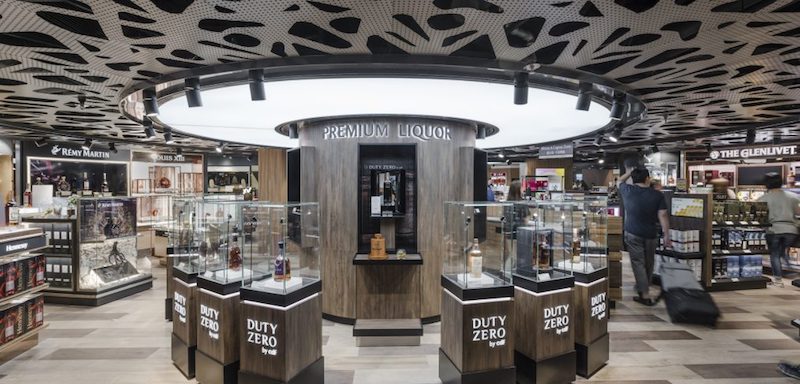
Hong Kong Duty Zero © Propaganda Studio Asia
Travelers are stuck in the airport for hours at a time. For retailers, that means a rare, captive audience not often found outside airport walls. It’s an opportunity to give travelers what they want—local food options, the chance to try on new makeup or souvenirs from local artisans and artists. Most airport retailers aren’t taking full advantage of this market, but they’re definitely feeling the pressure to provide more than just a tax-free bottle of wine and an extra-large Toblerone.
It’s a Generation Thing
Historically, travel has been considered a luxury. But in the eyes of many Millennials, travel has become a necessity and even a social currency. And wherever Millennials go, we know disruptors aren’t far behind.
According to the American Society of Travel Agents, Millennials take 44% more trips and holiday time than the average Baby Boomer (Source: Global Blue). They’re also 77% more likely to participate in bleisure : extending a business trip into a holiday. They value visiting new places and are re-writing the definition of luxury to focus more on experience and social capital over an upper echelon price point.
Generation Z isn’t that far behind. By 2020 they will make up 33% of the global community and will crave even more unique experiences. They are projected to have similar shopping habits to millennials, but they have higher expectations for the quality of a product and even less patience—they’re 60% less likely to use an app or site if it takes too long to load (Source: Global Blue). Expect these tendencies to spill over into their travel preferences as well.
Design is the Answer
So, what’s an airport retail brand to do? We’re working with a number of our clients on design strategies that will take them to the next level and engage more fully with the next generation of travelers.
Physically transforming the typical, cramped layout to be more shopper-friendly with wider aisles, a more generous flow, less crammed fixtures and a more diverse shop-in-shop experience is a great start. In addition, retailers should build in opportunities to take advantage of the social currency of travel by designing photo-worthy places and moments into their stores, all ready to be uploaded to social media along with the rest of their vacation photos.
Just as cities are rebranding to play up what makes them one-of-a-kind destinations, airports are moving away from national chains to local operators, working with local brands restaurateurs and artisans, and even exclusive pop-up stores that become a travel experience in and of themselves.
At Hong Kong International Airport, we reimagined the duty-free offering through the newly opened Duty Zero stores. In the flagship store location, 11 different zones reflect the various merchandise categories as well as the local context while customers experience curated moments like local high tea, a chateaux wine vault and a whiskey distillery, along with an iconic red Hong Kong taxi perfect for Instagram.
Technology is used throughout to engage customers including a digital sommelier in the wine vault where customers can place their chosen bottle on a digital media table, which pops up information about the winery, vintage and best foods to pair with it. These types of unexpected, immersive and streamlined tech experience leave a lasting impression on customers.
What’s Next?
Integrating tech into travel retail has its own challenges. In the travel retail world, where many operating rights are shorter than traditional leases and fit-outs are fast paced, the costs and infrastructure required for tech applications can be seen as problematic, but it also presents an opportunity. Retailers need to be smart about the types of technology they implement by thinking of applications that are useful and meaningful to their customer and allowing it to remain relevant over a period of time. Balancing the right amount of immersive tech in the built environment while using real-time data analytics to create better offerings for customers will pave the way for the future of airport retail.
Wherever you land in the world, expect to see more engaging, local retail experiences that may make you rethink what it means to spend time at the airport.
More from Author

CallisonRTKL | Dec 20, 2021
Digital nomads are influencing design.
As our spaces continue to adapt to our future needs, we’ll likely see more collaborative, communal zones where people can relax, shop, and work.

CallisonRTKL | Jun 30, 2020
The great reset and our new work life.
As many countries begin to return to the office, it’s a chance to ask ourselves: what do we truly value?

CallisonRTKL | May 4, 2020
How working from home is influencing design.
The lessons learned in the next few months can help shape how we work and design in the future. For now, remote work is different – and our new normal.

CallisonRTKL | Feb 26, 2020
Sustainability in a material world.
The concepts of embodied carbon, zero waste, and deconstruction and reuse often run on parallel tracks.
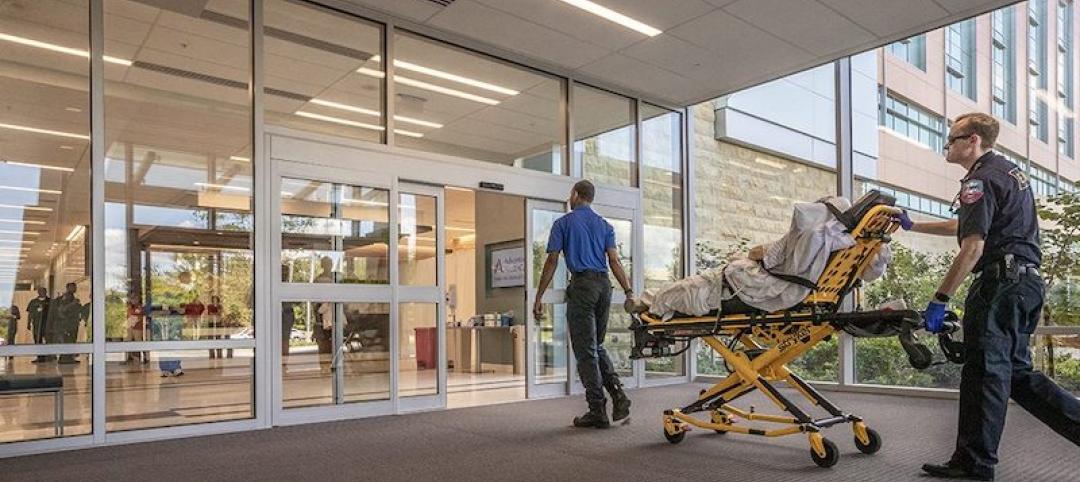
CallisonRTKL | Jan 30, 2020
The complex dance of healthcare transitioning.
Hospital employees, though excited about technological advancements, are expected to navigate a new workplace and care for their patients at the same time, all while training on new equipment and navigating a new building.
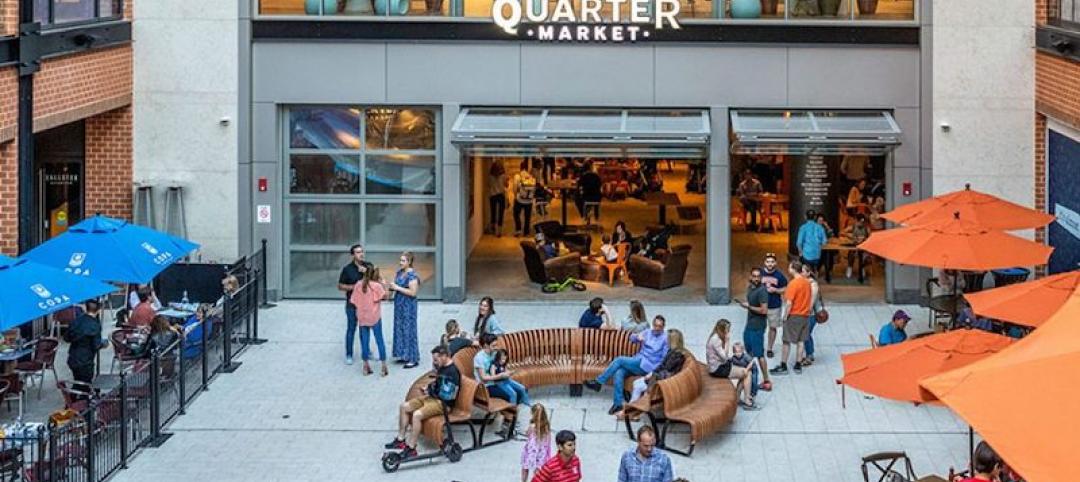
CallisonRTKL | Jan 6, 2020
Retail re-invention: five questions to ask.
Why have some malls survived their long-predicted demise, thriving and bumping with new generations of shoppers, while others have been relegated to the ash heap of deadmalls.com?

CallisonRTKL | Aug 6, 2019
Saving the american mall in 5 steps.
CallisonRTKL Vice President Marc Fairbrother explains how struggling American malls can turn it all around.
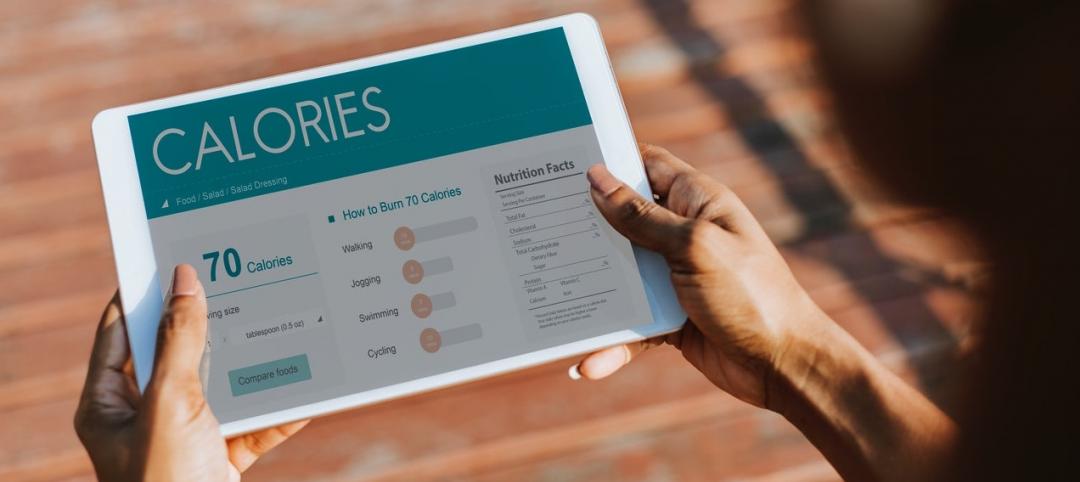
CallisonRTKL | May 29, 2019
Smart buildings can optimize wellness.
Employees want wellness initiatives built into their work experience, especially when they’re in spaces that can leave them feeling stiff, stressed, and sick.
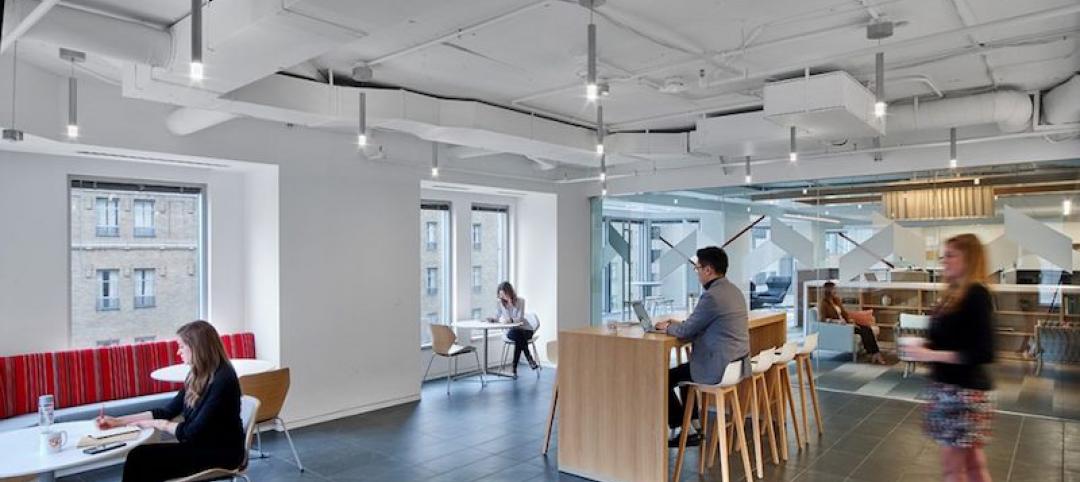
CallisonRTKL | Apr 5, 2019
2019 trends in the workplace.
From retention and career advancement to the ethics of inclusion and diversity, these five trends will play a major role this year in design, strategic planning and workplace development.

CallisonRTKL | Jan 28, 2019
9 tech trends to track in 2019.
Innovations in voice recognition, cognitive neuroscience, and biometrics are among the trending tech topics for 2019, according to CallisonRTKL's Kristin Tilley.
Top Articles
Mfpro+ news, special multifamily report indicates ‘two supply scenarios’.
- University Buildings
UNC Chapel Hill’s new medical education building offers seminar rooms and midsize classrooms—and notably, no lecture halls
- Codes and Standards
California law that ended single-family zoning is struck down by court
More in category, office buildings, most popular content.
- BD+C University (CEUs)
- MultifamilyPro+
- Giants 400 Rankings
- Life of an Architect
Building Sector Reports
- Airport Terminals
- Data Centers
- Government Buildings
- Healthcare Facilities
- Hotel Facilities
- Industrial Facilities
- Justice Facilities
- K-12 Schools
Building Sector Continue
- Laboratories
- Military Construction
- Modular Building
- Multifamily Housing
- Office Building Design
- Performing Arts Centers
- Religious Facilities
- Retail Centers
- Senior Living Facilities
- Sports and Recreational Facilities
- Transportation & Parking Facilities
- Burns & McDonnell
- CallisonRTKL
- CannonDesign
- Clark Nexsen
- CO Architects
- Design Collaborative
- FXCollaborative
- Gresham Smith
Blogs Continue
- HMC Architects
- IA Interior Architects
- Kimley-Horn
- Legat Architects
- NAC Architecture
- Nadel Architecture & Planning
- Perkins and Will
- Perkins Eastman
- Rider Levett Bucknall
- Shepley Bulfinch
- Southland Industries
- SRG Partnership
- Ted Goldstein, Atlas Tube
- Vessel Architecture & Design
- Walter P. Moore
Building Team Reports
- Contractors
- Building Owners
- BD+C University
- Building Enclosures Series
- Case Studies
- COVID-19 Reports
- Native Series
- Press Releases
- White Papers
BD+C Awards Programs
- 75 Top Products
- 40 Under 40
- Women in Design+Construction
- See all events

Magazine Subscription
Get our newsletters.
Each day, our editors assemble the latest breaking industry news, hottest trends, and most relevant research, delivered to your inbox.
Follow BD+C:
The future of airline retailing is now
Engagement with our partners, travel industry bodies, and influencers, has highlighted airline retailing as a recurring theme. As highlighted in our white paper on the 'Future of Distribution' last year, airlines must adapt their approach if they are to thrive in the new era of distribution; yet the path to delivering airline retailing remains largely unexplored. As outlined by Yanik Hoyles of IATA, becoming retailers is both the biggest challenge and opportunity that airlines must face.
" In my opinion the airlines ' biggest challenge today is how to become true retailers bearing mind the industry 's current constraints as well as the inertia towards status quo. The beauty of challenges though is that they can always be transformed into opportunities when looked at from a different angle. " - Yanik Hoyles, Director, New Distribution Capability (NDC) at IATA
In this article, we seek to enable airlines to take their next step towards retailing. As well as exploring the factors that have encouraged airlines to shift towards a retail-oriented mentality, we will highlight the Skyscanner learnings and products that can support the transition of airlines towards retail - from our experience with bots, to our mobile-optimised Direct Booking solution.
The transition from desktop to mobile, voice and bots
Our view of what constitutes a 'direct booking' has been disrupted by the shift in consumer behaviour away from desktop towards mobile. Travel companies with mobile apps saw 60% of their bookings take place on mobile devices in Q4 2017 according to Criteo's 2018 industry report , up from 41% during the same period in 2016, while online travel agents now see almost half (45%) of all bookings take place on a smartphone or tablet. A trend we have seen replicated at Skyscanner, where we have experienced a combined annual growth rate of 40% in visitors to mobile during the last three years, and accrued over 70 million app downloads worldwide. Our 2018 data on daily organic app installs indicates that our trend towards mobile growth will continue, and accelerate into the second half of 2018.
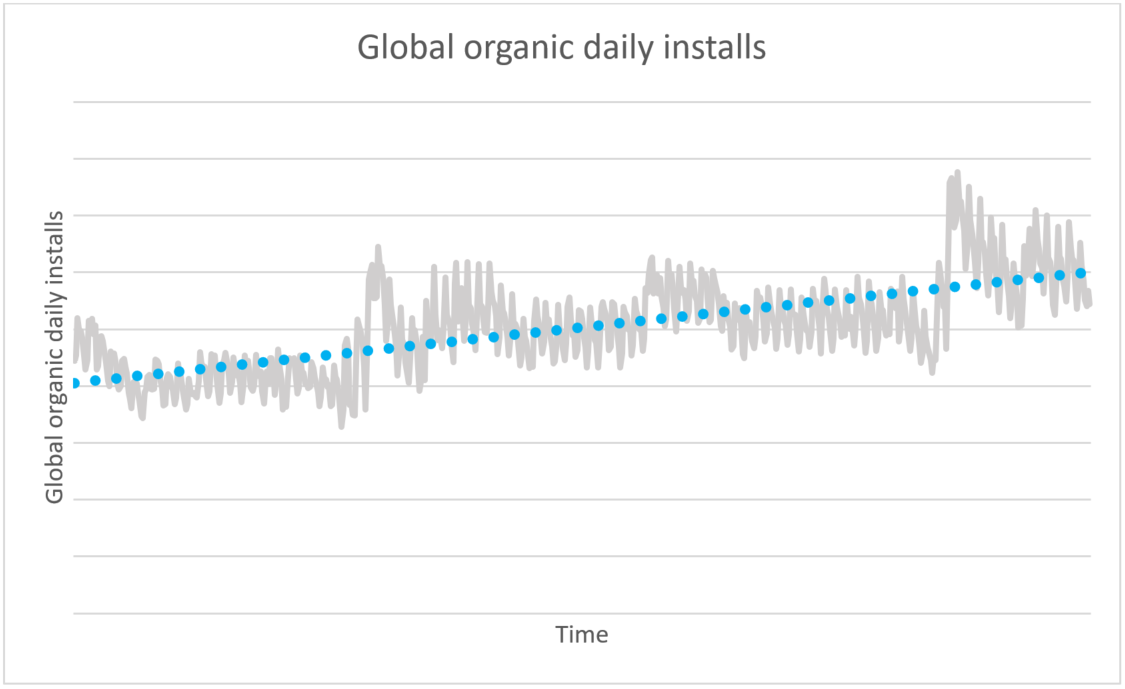
Simultaneously, industries including travel have experienced the rise of mobile e-commerce (m-commerce), and the coinciding shift in consumer expectations; towards an integrated shopping experience in which inspiration, selection, results, booking and payment are all instantaneous.
This disruption in distribution has been enhanced by the increasing reliance on bots and voice assistants, as travellers migrate from the click-type-tap patterns that are common in apps and sites, to a more conversational format in which they ask casual, but fully-loaded questions.
" Online distribution used to be a case of it 's either on your website and it 's first party or it 's third party. Mobile has changed the picture. Not only do you have apps and much smaller screen space, but you 're also now getting voice technologies: Google Home, Alexa and others, first party, third party. So really there is a blurred line and a gradation of degree of first party and third party. " - Gareth Williams, co-founder and CEO
We have now drawn more than one million unique interactions across our Skyscanner chat interfaces - Facebook Messenger , Amazon Alexa , Microsoft Cortana and Skype Group Chat Travel Bot . We have learned a lot (link to Filip's interview) through our experiences, including that pure voice communication is very challenging.

" Voice works well if you are doing utility functions, such as ' what ' s the weather going to be tomorrow? ' ; but conversations don ' t always follow a predictable question-and-answer structure. We learned quickly that we needed to create hundreds of paths so users wouldn ' t end up in a dead-end where the conversation just stops. " - Filip Filipov, Vice President for Product Management, Skyscanner
And for brands that are just starting to explore voice technology, Filipov has given this advice: if software engineering is not at the core of what you do, don't go it alone.
" We are a technology company. And we have decided that this is an important channel. We ' ll learn, we ' ll build it, we ' ll continue building it, we ' ll pause it at certain times, we ' ll double down on the investment. But if you are a brand that doesn ' t have the capabilities in terms of technology, don ' t do it. Get someone else who can build it for you. " - Filip Filipov, Vice President for Product Management, Skyscanner
We need to Look East for future mobile trends
When it comes to mobile adoption, countries such as China and India are well ahead of the curve as detailed in more detail in our white paper on 'The road ahead in China' . In China 43% of bookings are completed on a mobile device, and India has reached 20% ( Worldpay ). These nations of early adopters offer unique insight into where other global markets will be in the next five to ten years, and highlight two areas that require focus: the future of retail, and payments.
In their move online, retailers mirrored many of the features consumers valued in brick-and-mortar retail (e.g. tailored offers for a personalized service, interactive visual media in place of a catalogue), whilst offering an always-on solution that provided context through social media and reviews, and time to consider high involvement purchases such as travel. However, the online environment has resulted in brands becoming increasingly commoditized.
Looking to China, retailers such as Alibaba's Tmall have bucked this trend by combining advanced search capabilities with content to help consumers evaluate goods, whilst enabling each "store" to maintain unique branding. This is in line with the preferences of the majority of Chinese consumers who value seeing an extended range of products (68%) and an inviting ambiance (63%), and has resulted in Tmall being actively used by 97% of Chinese online shoppers. It also benefits suppliers, as it gives them the space and ability to control the display of their products through 'store-fronts' of sorts, with abundant up-sell opportunities built-in. This has implications, as airlines seek both to develop themselves as retailers and tap into the Chinese market which has eluded many international businesses to date. Considering the preferences of consumers in this market, definitely has the potential to deliver returns.

In addition to the above, Tmall adds value through the efficiency and simplicity of its shopping process adds value - and payment forms a critical part of this. Alibaba has introduced its own form of payment known as Alipay, which boasts 520 million users and supports a wide range of payment channels. Other third-party payment systems such as UnionPay and WePay are also popular; providing users with secure, joined-up and mobile-friendly payment solutions.
Another developing trend with new mobile devices is the introduction of biometric readers such as Apple Touch ID, which will enhance the security of transactions over time whilst eliminating a point of friction in the booking process.
" It allows for easy input via fingerprint rather than lengthy password and verification methods. Companies like Alibaba and Xiaomi are also exploring secure log-ins via facial recognition and Retina scans. Over time, the idea of a password might change. Verification would be with the device and biometric information. " - Filip Filipov, Vice President Product Management, Skyscanner
Mobile transactions are also likely to become even more popular over time because they are inherently more secure than browsers for online shopping, especially when an app is tied to the phone-requiring the use of Touch ID to open the app, for example. In this case, you combine online verification-passwords and accounts-with locally stored information such as Touch ID. While one of them might be compromised, it is rare both would be. Also, in terms of payment security, mobile is further ahead than computers and verification can be more easily introduced.

For airlines, this means that their approach to payments will become an even greater determinant of their conversion rate and business performance. As explored in our article on 'Optimising payments for performance' , delivering a user-friendly booking flow, and providing support where necessary will not only improve your performance in the short-term. It will also help to retain users; and drive up their lifetime value. This was highlighted by Svante Westerberg, from Skyscanner payments partner Braintree in a recent interview.
"Booking and buying travel and travel experiences typically involves extensive research and high-ticket items. Once a user has discovered, browsed, and selected a product, any type of friction in the checkout -including onerous requirements, slow load times, lack of global payment options, or unfamiliar redirects -can cause a user to abandon their cart, especially on mobile where real estate and attention spans are limited. " - Svante Westerberg, Head of Global Strategic Development, Braintree
Westerberg also highlighted how travel retail is "evolving from a one-off, holiday-oriented experience to a consistent dialogue with the consumer".
The new storefront
Recognising the shift in distribution that has been brought-about by mobile, bot and voice technologies and changing customer behaviour and expectations, we have invested in what we consider to be the future of distribution: Direct Booking .
Direct Booking is all about providing a flexible, optimized retail experience, with features which bring the right options to the top of the search in the increasingly small space of the mobile front page. It is designed to put the retailer's brand at the forefront and ensure a direct connection to the consumer, regardless of the context of purchase.
" Direct Booking, in essence, is putting your booking engine in front of the traveller in locations beyond your own website. It is the evolution of metasearch in a highly cost-efficient, lightweight, frictionless way. Direct Booking allows the sale of ancillaries. It allows the booking to go into your own system, it allows you to follow-up with the customer straight after the booking. " - Gareth Williams, co-founder and CEO

Not only will this serve to counteract the commoditisation of brands in the metasearch environment, but it will also add value to our users by enabling them to complete the transaction within our environment. As users become increasingly mobile, they will migrate from the click-type-tap patterns that are common in apps and sites; so meta needs to evolve from purely being a click-out business.
" I think over time what we ' ll see is meta will move from the click-out model to a model that is more relevant for the needs of the user and partners - which is simple, seamless transactions. " - Filip Filipov, Vice President Product Management, Skyscanner.
The evolution of Skyscanner towards Direct Booking has already delivered returns for early adopters, with existing partners experiencing an uplift in booking conversions on basic tickets upwards of 20% across the board, and 50% on mobile. Additionally, there has been an uplift in ancillary ticket sales of over 100%.

Airlines that are currently looking to integrate with Direct Booking are also benefiting from the ability to get set-up quickly. Direct Booking is compatible with any NDC-ready provider, and the full set up process is outlined in our 'Guide to NDC' delivered in collaboration with IATA. We can also support other integration types.
Are you retail ready?
With the data continuing to highlight the shift from desktop to mobile, and the retailing and payments trends that are emerging from the East, it is time to ask: what are you doing to enable your brand to thrive in the hyper-connected, mobile-centric and increasingly fragmented world that you operate in?
If you aren't already embracing the digital disruption in distribution, now is the time to.
Interested to hear more about 'Embracing digital disruption in airline distribution'? Join Hugh Aitken (Senior Director, Strategic Partnerships, Skyscanner) and other panellists at the CAPA Americas Aviation Summit.
You can also get in touch with us to learn more about how Skyscanner can support your business through Direct Booking.
Get in touch
- south pacific
- the americas
You are using an outdated browser. Please upgrade your browser to improve your experience and security.
_w=800_h=392.webp?v=20230522122229)
Posted on Mar 25th, 2022 at 16:10
Future of Travel Retail: Understand the ‘messiness of human decision making’
Ogilvy’s Rory Sutherland on the relationship between tech and psychology
Travel companies must understand how human psychology and emotion play a pivotal role in customer behaviour rather than trying to measure everything rationally.
This week’s Travelport Future of Travel Retailing in Dubai heard from non-travel industry speakers discussing the relationship between technology and customer behaviour.
Marketing and market research expert Rory Sutherland, vice chairman of Ogilvy UK, said firms must know what questions to ask and not always expect a logical, numerical answer.
“What really excites me particularly about this industry is the interplay between technology and psychology. Travel is a business of engineers desperately trying to pretend they are not in the entertainment industry.
“Airlines are a mixture of hardcore logistics combined with the fact that you are dealing with a bunch of completely irrational customers.”
Sutherland said travel retail interfaces have not been designed for consumer choice but more for the business traveller who knows the answers to questions like ‘where are you going’, ‘when are you going’ and ‘how much do you want to pay’.
“To a consumer all the answers to these questions is, it depends. We need to have a much better way of looking for travel which acknowledges the messiness of human decision making as opposed to the neatness of business decision making.”
Sutherland quoted Ford senior executive Kumar Galhotra who said: “Car making is a hundred thousand rational decisions in search of the one emotional decision.”
He said: “A lot of the things we look at like technology and engineering ultimately boil down to psychology.
“It’s deeply discomforting to an engineer because they are used to a world where you can quantify what matters – you have numbers for all the things that count.
“As soon as you enter psychology into the mix you enter a different world. If you look at a problem psychologically you might come up with different answers.”
Sutherland cited the automated vehicle pod parking service at Heathrow airport.
He said users are disappointed when offered an upgrade to a more premium and convenient service when it is unavailable because they want to ride in the pod.
“If we only try to optimise travel and transportation using objective numerical criteria we will miss out on a lot of things. We do not yet have adequate numerical objectives for how we feel.
“The trick is to ask more, better questions. We need to explore. The trouble with market research is people like what they say but they do not say what they like, and they don’t understand what they say.
“Do not rely on people to tell you what they want. The parts of the brain that do the feeling are not really connected to the parts of the brain that does the talking.
“You have to experiment, but not with everything. Established wisdom is established for a pretty good reason but you have to ringfence an area of about 10% to 20% where you are allowed to fail.”
Artificial Intelligence is developed to explore and exploit the trade off between what is already known and discovering what is not currently known either because the future is different from the past or because it’s not been discovered yet, Sutherland said.
“If you don’t have a certain degree of this optimisation built in you get too reliant on the past [as a predictor of the future], you do not get lucky, you do not have a system that allows to exploit lucky discoveries.
“You are trying hard to innovate simply based on what you already know rather than by exploring what you don’t yet know. You are trying hard to make every decision a factor of logical deduction.”
Sutherland described many of the most successful brands of the modern era like Starbucks, Dyson, Airbnb, Zoom, Amazon Prime, Nespresso and Red Bull as an “act of psychological arbitrage” in which consumers apply an irrational assessment of their relative value.
This is why Rolls Royce has stopped exhibiting its vehicles at car shows, because it makes them look relatively expensive, and instead shows them at superyacht and private jet shows, said Sutherland.
Uber’s map addresses the uncertainty of waiting for a cab and turns the experience into a positive one even if the actual wait time is the same for a rival cab firm, he added.
“Waiting for a taxi in conditions of uncertainty is agony for the human brain. There’s also an element of status where you time your departure from the building to exactly when the car is going to turn up. You feel like Louis the fourteenth. This is high status behaviour.”
In Dallas Forth Worth airport they are being deliberately ambiguous about where aircraft are due to leave from to stop people forming a queue to board too early. “The whole experience of waiting for a plane is messed up by the people who decide to queue early.”
Sutherland said travel firms should not base discounts on individual seat or ticket prices but to the people who are most price sensitive, like a family of five travelling as a group as opposed to a couple with two incomes.
“About 20% of people would be motivated to go on a later flight if you put on your website that this is the least crowded flight of the day,” he said.
“Economics and logic and numbers have taken over yield management, but there are lots of ways to direct human behaviour other than bribing them, which is an expensive way of doing it.”
Related Topics
This website uses cookies to ensure you get the best experience. Learn more
You are using an outdated browser. Please upgrade your browser to improve your experience.
REDEFINING THE END-TO-END PASSENGER EXPERIENCE AND BUSINESS PERFORMANCE
British Airways launches Customer Access Advisory Panel as part of commitment to inclusive and seamless CX for all
On the Ground | Up in the Air // May 2024
Share on LinkedIn LinkedIn Share on Twitter Twitter Share on Facebook Facebook Share on Reddit Reddit Share on Flipboard Flipboard Share on Tumblr Tumblr Share via Email Gmail Share on WhatsApp WhatsApp

British Airways – a member of International Airlines Group (a Headline Partner of FTE EMEA and FTE Ancillary & Retailing , Dublin, 11-13 June 2024) – has held the first meeting of its new Customer Access Advisory Panel. This is aimed at improving the end-to-end experience of customers with accessibility requirements. The airline is committed to delivering a seamless experience for everyone and is dedicated to ensuring that its accessibility offering meets the diverse needs of its customers.
“British Airways carries hundreds of thousands of customers who require additional assistance each year,” said Xavier Mascarell, Customer Accessibility Strategy Manager, British Airways and founder of the Customer Access Advisory Panel. “We work hard to remove barriers and support customers with accessibility requirements throughout their journey but know there is more work to be done. The insights and recommendations we receive from our advisory panel members will be vital to improving our accessibility offering. We want to ensure a positive flying experience for everyone and we hope the learnings we gain through these meetings will drive further change.”
The independent panel, comprised of individuals with both visible and non-visible disabilities, met in person for the first-time and will come together every few months to provide invaluable feedback and discuss and review new initiatives, to ensure that British Airways’ products and services are designed and built with accessibility and inclusion front of mind. From IT solutions to airport and onboard experience, the panel will play an important role in shaping improvements within the airline and provide practical recommendations on best practices for inclusivity, informed by evidence and supported by lived experiences.
“I’m over the moon to support British Airways as Chair of its new Customer Access Advisory Panel as this demonstrates a visible commitment from the airline’s leadership to make flying more comfortable and dignified for everyone,” said Mary Doyle, Chair of the Panel. “Tailoring the customer experience is key to our success, as disability is not one-size-fits-all. We have a great team of professionals with lived experience on the panel who are curious, innovative and put the customer at the centre of all decisions. This team is committed to helping British Airways learn directly from the disability community and we’ll have some fun along the way.”
Hear more from International Airlines Group (IAG) at the co-located FTE EMEA and FTE Ancillary & Retailing events, taking place in Dublin on 11-13 June 2024. Harvey Tate, Human API – Digital Transformation, IAG, is speaking in a session focused on ‘What are the new technologies and approaches, that can make a transformational difference to the ways air transport stakeholders will operate in the future?’ He will deliver a presentation titled: ‘IAG is exploring a path to dark airport (fully autonomous) operations in the future, but how long might that take to achieve and what does it need to see from industry stakeholders to make such a vision a reality?’
Martin Thomas, Implementation Manager, Airports Automation, IAG Airports, will deliver a scene-setting presentation in ‘The FTE APEX Lounge Innovation Summit’ titled ‘The latest thinking on the way to develop, and run lounges, across the IAG group’.
Meanwhile, Annalisa Gigante, Board Member of Hangar 51 & Head of Innovation, IAG, is participating in the ‘Closing Leaders Keynote Session’ – a fast-moving and entertaining panel discussion on customer-centric innovation and business transformation.
IAG Airports speaking at FTE Aviation & Robotics Summit, Pittsburgh, 14-16 May 2024
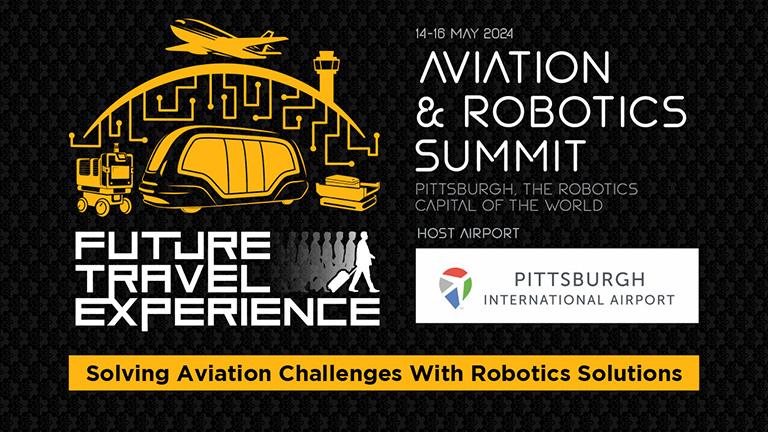
The FTE Aviation & Robotics Summit takes place in Pittsburgh – the ‘Robotics Capital of the World’ – on 14-16 May 2024. Thomas Cannell, SVP Airports Futures, IAG Airports, is participating in a session titled ‘Where the rubber meets the runway: Navigating expectations, requirements, implementation, and outcomes when testing and deploying technology through partnership’.
You may also want to read...
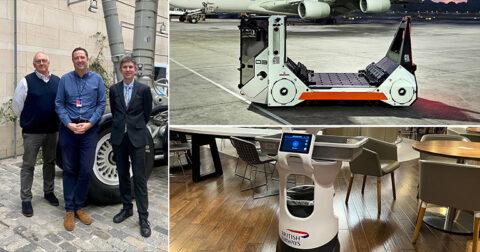
FTE exclusive: IAG discusses collaborative approach to industry transformation and how it is trialling Robotics & Automation, AI, and much more across the ramp, lounges and accessibility
International Airlines Group (IAG) invited FTE for a briefing on its innovation activities. We learned how IAG will be collaborating with its partners on trials covering robotics & automation, AI & ML, and more.
Digital Transformation , On the Ground , Robotics & AI , Startups // Feb 2024
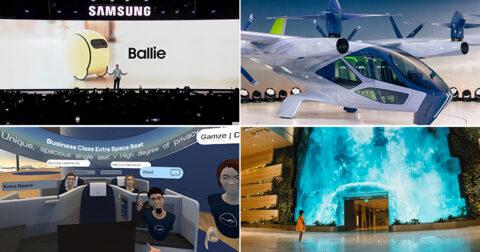
12 technology and CX trends that can enhance airline and airport operations in 2024
FTE explores a selection of the top trends and technologies for 2024 and beyond, including robotics and automation, biometrics and digital identity, sustainability, Urban Air Mobility and more.
Ancillary , Biometrics , Digital Transformation , Mobility , On the Ground , Personalisation , Robotics & AI , Startups , Sustainability , Up in the Air // Jan 2024
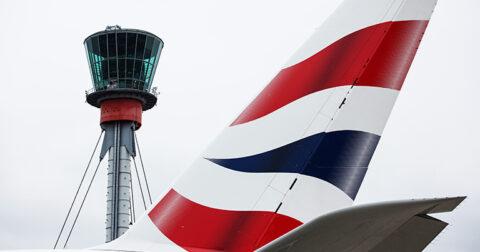
British Airways partners with Amadeus on journey towards enhanced retailing capabilities using AI technology
British Airways – a member of IAG (a Headline Partner of FTE EMEA and FTE Ancillary & Retailing, Dublin, 11-13 June 2024) – is partnering with Amadeus on enhanced retailing capabilities using AI.
Ancillary , Digital Transformation , In-flight , Up in the Air // Apr 2024
Future Travel Experience Ancillary
11-13 June 2024, Dublin
Empowering the airline sector to profit from collaborative digital retailing opportunities at every step of the journey
Future Travel Experience EMEA
A gathering of air transport’s digital and innovation leaders, creative designers and progressive minds who will inspire one another and reimagine travel together.
Future Travel Experience Global
28-30 oCT 2024, California
Where the world's most progressive travel facilitators define tomorrow’s end-to-end passenger experience

Future Travel Experience APEX Asia EXPO
19-20 November 2024, Singapore
Connecting vendors with airline and airport executives to transform tomorrow’s end-to-end passenger journey across Asia-Pacific
Get Future Travel Experience news & updates sent to your inbox
- Knowledge Hub
- Product Status

Find a Data Set
- Browse All Data Sets
- Global Airline Schedules Data
- Flight Status Data
- Historical Flight Data
- Flight Seats Data
- Flight Emissions Data
- Minimum Connection Times
- Master Data
- Passenger Booking Data
- Global Flight Connections Data
- Airfare Data
How we deliver data
- Data Delivery
- Latest Product Updates
Data Suppliers
- Share your data
Try our Data
Flight data sets.
The world's most accurate and information-rich flight data
ANALYTICS PLATFORM
- Analyser Analytics Platform
EXPLORE ANALYSER MODULES
- Connections
DEMO ANALYSER PLATFORM
Powerful aviation analysis platform to drive commercial and operational decision making across the industry.
WE POWER THE AIR TRAVEL ECOSYSTEM
- Consultancies
- Governments & Security
- Travel Technology
- Airport Service Providers
TRUSTED BY LEADING ORGANISATIONS
- Air Black Box
- View All Case Studies
Springshot: Minimizing delays with OAG's Status Data
- All Blogs, Webinars & Podcasts
- Covid-19 Recovery
- Future of Travel
- Aviation Market Analysis
- Aviation Sustainability
- Data, Technology & Product
- Where To Meet Us
- Monthly Live Webinars
- Travel Recovery Tracker
- Busiest Flight Routes in the World
- Busiest Airports in the World
- Airline Frequency and Capacity Statistics
- Monthly OTP Analysis
- Middle East Market Analysis
- US Aviation Market Analysis
- South East Asia Market Analysis
- China Aviation Market Analysis
- View All Analysis
MIDDLE EAST AVIATION
Transformation, growth and future challenges.
Discover our latest in-depth report focused on the Middle East aviation market.
OUR COMPANY
- Diversity & Inclusion
- OAG & The Environment
- Our Locations
- What's New At OAG
GET IN TOUCH
- Press Office
Explore a career at OAG. See the latest job openings here.
Navigating the Future of Air Travel: Insights for 2024

In the ever-evolving realm of air travel, the coming year holds a multitude of developments and challenges. Join us as we navigate through the trends and issues that will define the aviation landscape in 2024.
The skies may present challenges, but they also offer opportunities and innovations that will shape the future of air travel. Here’s what we anticipate will shape our journeys through the skies next year.
1) Soaring Prices or Smooth Sailing? Unpacking 2024 Fare Predictions
In 2024, expect a continuation of the status quo in flight prices, with minor fluctuations. Off-peak seasons may offer some relief due to softened demand, but the underlying factors, such as increased salaries and fluctuating oil prices, suggest a stable rather than cost-saving experience.
Keep an eye on routes with additional capacity, particularly in the transatlantic sector, as legacy carriers, led by United Airlines, open new routes, potentially influencing fare dynamics.
2) Turbulence Ahead: Persistent Disruptions and Global Issues
The year ahead won't be without challenges. Lingering disruptions from the previous year and global issues may impact the aviation industry. The Pratt & Whitney engine problem is expected to peak, potentially grounding up to 300 aircrafts globally at any given time.
Carriers like Lufthansa, Indigo, Delta Air Lines, Wizzair, and Virgin Atlantic may experience disruptions from these delays. Some airlines, however, might find opportunities with these engine delays. With reduced capacity, they have an opportunity to exert higher fares.
Boeing’s recent backlog issues add another disruption for airlines that simply don’t know when their new aircraft will be arriving next year, making planning a bit difficult for some.
3) Business Travel 2.0: Short-Haul Sector Faces Uphill Climb
The return of business travel has started post-pandemic, but not all sectors will recover at the same pace. Short-haul business travel may continue to lag behind, as video calling and conferencing options prove to be more time and cost-effective for many professionals.
Then in Europe, regulators are impacting short hall travel with new regulations. With a goal of cutting carbon emissions, new regulations have been put in place that ban short distance travel via plane. For example, in France, the Government has banned flights from domestic airports within a four hour train journey of Paris.
4) AI Takes the Pilot's Seat: Innovations in the Industry
Technological advancements will continue to take center stage in 2024. While drones and VTOLs remain on the horizon, Artificial Intelligence (AI) applications are set to revolutionize the aviation landscape.
We can expect transformative changes with AI, from optimizing operations to enhancing passenger experiences, AI will continue to be a driving force behind industry advancements.
5) The Dogfight for Dominance: Low-Cost Carriers (LCCs) vs. Legacy Giants
The struggle for market share and profitability continues in 2024 between Low-Cost Carriers (LCCs) and legacy giants. Both entities will compete vigorously, with legacy carriers challenging the LCCs. However, LCC’s will need to persevere to secure their market share and revenue.
Consumers will always come back for a low fare –and that’s helping LCC’s maintain a competitive stance. There is a growing share of capacity behind flights operated by LCC’s. Some of the U.S.’s largest airports have seen a huge boost in flights operated by LCC’s in the past 3 years, and that’s expected to grow.
As we look ahead to 2024, stay tuned for more insights and analyses from OAG, You can subscribe to receive an alert when we publish a new article below.

Recommended:

We’re always adding new content, keep up to date by registering your interest here.
View our Privacy Notice
Related Insights
Scandinavia’s star to shine less brightly.
02 May 2024
Japan’s Slowly Rising Recovery: Swimming against a Tide of Adversity
01 May 2024
Taylor Swift: Singapore’s Love Story
11 April 2024

Volkswagen GEN.TRAVEL: A Glimpse into the Future of Mobility
I n September 2022, Volkswagen unveiled the GEN.TRAVEL concept car, an autonomous Level 5 electric vehicle that redefines the concept of travel and interior space. While the interior is certainly noteworthy, it's the exterior design that truly sets this concept apart.
A Design that Breaks the Mold
From its front to its rear, from its overhangs to its top, the GEN.TRAVEL blends circular and angular lines into a well-defined concept, featuring a windshield and rear section that are unlike anything we've seen before. It's a low-slung vehicle, allowing for a complete and comprehensive appreciation of its exterior.
A Glass Capsule for a Stress-Free Ride
The essence of its exterior lies in its transparent glass cabin, which is integrated into the lower part. The essence of its interior, as I've already detailed in this article, lies in its hermetic nature, making it a truly anti-stress car. The gullwing-style side doors provide passengers with efficient entry and exit.
A Level 5 Autonomous Vehicle with Advanced Suspension
The GEN.TRAVEL is a Level 5 autonomous vehicle, equipped with eABC (Active Body Control electric) active suspension . This system calculates all its movements, from vertical and lateral to acceleration, braking, and cornering, in advance. This allows the four-seater to achieve a certain style and optimize its trajectory.
What do you think of the GEN.TRAVEL's exterior design? Check out the images and decide.
The GEN.TRAVEL is more than just a concept car; it's a glimpse into the future of mobility. With its unique design, modular interior, and advanced autonomous driving capabilities, the GEN.TRAVEL represents a world where transportation is not just about getting from point A to point B, but about creating a seamless and enjoyable journey.

Tipping is 'not an entitlement': Should travelers stop tipping for everything?
Tipping is dead.
At least tipping, as you and I understand it. A mandatory 20% gratuity on every restaurant meal? Obligatory tips for housekeepers, concierges and tour guides? Kiss them goodbye.
And if you want to know why, just ask Gerri Hether.
Like many Americans, she's tired of the attitude that all service workers are entitled to a tip. She became exasperated with the point-of-sale terminals that solicited a gratuity before even serving her food. But then the final straw was when restaurants started to add automatic gratuities to their bills for her "convenience."
"I don't tip anymore," said Hether, a retired nurse from Mesa, Arizona.
Learn more: Best travel insurance
Check out Elliott Confidential , the newsletter the travel industry doesn't want you to read. Each issue is filled with breaking news, deep insights, and exclusive strategies for becoming a better traveler. But don't tell anyone!
Americans are known for generosity and willingness to tip for good service. But a recent poll by USA TODAY's Blueprint found 63% of respondents say too many businesses are asking for tips, and 48% are tired of being asked for a gratuity.
Almost the same number of Americans (62%) in another survey said they wouldn't give service workers year-end tips, according to the digital personal finance company Achieve. The reason? Tip fatigue.
This type of vacation rental cancellation is on the rise. Are you next?
'Expensive in every way': What travelers should expect this summer
Why Americans have had enough of tipping
An increasing number of Americans believe that tipping expectations are unfair, said Carla Bevins, an expert on business management communication at Carnegie Mellon University’s Tepper School of Business. And that has led to a shift in public attitudes toward gratuities.
"The momentum behind the no-tipping movement stems from growing scrutiny over the fairness and necessity of traditional tipping practices," she explained.
To hear people like Ian Duncan talk about it, it's a reaction to the widespread attitude of entitlement in the hospitality industry. It's tip jars at coffee shops, laundromats and grocery stores. It's having to pay a gratuity before you even receive a meal or service.
Duncan, a small business owner from Toronto, recently booked a cruise. However, when he received his invoice several weeks before his departure, the cruise line had added more than $200 in automatic gratuities to his bill .
"That did it for me," he said. "I canceled the trip and asked for my deposit back."
Duncan said he wants to decide who and when to tip – or whether he should tip at all – and resents it when a company assumes it is entitled to a gratuity. He also doubts that the staff will receive any automatic gratuity added to his bill, which is a valid concern.
Even etiquette experts say the time has come to talk about tipping.
"Tipping evolves over time, and we are long overdue to revisit the legal and social norms for how employees are paid," said Jodi RR Smith, an etiquette expert with Mannersmith Etiquette Consulting . "Expecting individual consumers to tip generously at every turn is not a long-term plan for economic success."
Even service workers agree that it's gone too far
Even people who depend on tips understand that things have gone too far. Mike Aguirre, a blues guitarist who performs in the Caribbean, blames the new terminals that try to extract a tip from patrons before they receive their meal.
"Leaving a tip before you receive your order seems premature − no service has been rendered yet, but there is a palpable element of guilt involved," he said.
It gets worse, actually. In some places abroad, restaurant servers come to your table with a portable payment system and ask you to enter a gratuity while they watch . Talk about pressure!
But people like Aguirre are likely to suffer because of the understandable tipping backlash. Many service workers have come to depend on gratuities to earn a living. Squeezing a tip out of a customer before the meal is served or under the watchful eye of your server is hardly the fault of the employee. However, the employees are likely to pay for these misguided policies.
Even etiquette experts have limited their tipping. Etiquette consultant Rachel Wagner said she no longer tips at hotel self-serve snack bars (even when there's a tip jar), at restaurants where you order at the counter, and at airport food kiosks.
"When the terminal shows me the tipping options, I choose 'no tip,'" she said.
She calls these kinds of tips "entitlements" and isn't worried about a service worker's reaction.
"All this person has done for me is take my money and place my items in a bag," she said. "There is no need to tip!"
Flying cars are coming! Here's how they could change the way you travel.
'Flying feels different': Here's how air travel has changed recently
How to avoid tipping
Fact is, most service workers continue to rely on tips, and many believe you should always leave a gratuity. But there are ways to sidestep this unspoken obligation.
- Go to a no-tipping business. Some hotels and restaurants advertise themselves as "no tipping." The easiest way to avoid a gratuity – and to encourage other companies to adopt sensible policies on tipping – is to give these companies your business. Have dinner at Thattu in Chicago, an Indian restaurant that pays its servers a competitive wage and doesn't solicit tips. Or Casa Bonita the Mexican Restaurant in Lakewood, Colorado, that doesn't accept gratuities.
- Get takeout. No reasonable person expects you to tip your restaurant worker when you get takeout. So, one way to avoid leaving a gratuity is to get your next restaurant meal to go.
- Refuse to tip. You can also send a message to a business about tipping by putting a zero in the tip line. Hether, the retired nurse who has stopped tipping, said the reaction from service workers has been one of resignation. It seems they know the system is broken, but they don't know how to fix it.
The future: Gratuities based on good service
When it comes to tipping, the future may look a lot like the past. Travelers say they don't think it's fair that they should subsidize a service worker's salary with a mandatory gratuity. But they like the traditional idea of offering a service worker a little extra for exceptional service.
Hether said she's still open to rewarding good customer service with a gratuity. But she'll never again fork over 20% of her bill out of a sense of obligation.
"Tipping should be based on exceptional service," she said. "It's not an entitlement."
Christopher Elliott is an author, consumer advocate, and journalist. He founded Elliott Advocacy , a nonprofit organization that helps solve consumer problems. He publishes Elliott Confidential , a travel newsletter, and the Elliott Report , a news site about customer service. If you need help with a consumer problem, you can reach him here or email him at [email protected] .

IMAGES
COMMENTS
Future of Travel Retail Industry. Though the Covid-19 pandemic and the subsequent lockdowns put a strain on the travel and the travel retail industries, market analysts are confident that both these industries will register huge growth rates in the post-pandemic world. Also, digitization of financial services has improved the quality of ...
The future of the travel industry will depend on more than just travelers' pent-up demand. For some, the romance that travel used to inspire was already wearing thin even before the crisis. ... "Airline retailing: The value at stake," November 2019. —equivalent to 4 percent of 2019 revenues—by 2030. ...
Then, when physical stores shut down in 2020, retail sales fell 20% from February to April. As aircraft were grounded, the travel retail industry weathered severe losses. Although we're now in the ...
The Future of Travel Retailing: Elevating the Passenger Experience. Sabre is forging ahead in its ambition to modernize travel industry standards and accelerate retailing transformation, standing shoulder-to-shoulder with IATA in a shared vision for the future. Over the coming weeks, we will lead you step-by-step on that journey towards change.
The upshot is that travel retail players need to adapt to survive. In short, airports, retailers and the entire ecosystem must embrace the new market dynamics. To do this, we believe they need to focus on two key areas: revamping their traditional offer and reinventing their business models. Below we give our recommendations.
The underlying precept is that travelers may want to escape to nature, to experience freedom in serene landscapes rather than spend time shopping when travel bans are eventually lifted. Tourists radiating away from urban centers could dampen the much-hoped-for revival of travel retail spending. Yet, predicting future trends in Asian travel is ...
Industries in Depth. "People want to travel": 4 sector leaders say that tourism will change and grow. Published May 24, 2022· Updated Jan 11, 2023. The global travel and tourism industry's post-pandemic recovery is gaining pace as the world's pent-up desire for travel rekindles. Image: Unsplash/Anete Lūsiņa. Anthony Capuano.
3. Travel's moment for the metaverse has arrived. Whether you believe the hype or not, it's impossible to talk about the future of travel retailing without looking to the metaverse. Expert Consultant, Steve Bambury, introduced three applications for metaverse in travel during our event in Dubai.
The future of artificial intelligence and machine learning in travel retailing is bright. Better targeting and engagement with customers will manifest in enhanced pre-travel experiences, that could include destination, route and travel date recommendations, alerts for preferred destinations, price predictions for desired itineraries and virtual ...
In this moment of incredible change, there are huge opportunities to rethink, revamp and modernize the travel retail space. Travelport is teaming up with executives from American Airlines ...
So far in 2024, the global travel industry is seeing a significant resurgence, accompanied by a noticeable trend: People are becoming more skilled at planning their trips and are mastering the art of travel. Equipped with a wealth of online tools, these travelers are tailoring their itineraries to ensure enriching experiences at maximum value.
Travel retailing is the process of selling and servicing travel and related products. 'Retailing' goes beyond selling to consider the holistic customer experience, not just a simple transaction. Modern travel retailing refers to retail experiences that meet and exceed the expectations of today's travelers. It involves frictionless, intuitive, and personalized shopping, booking, and ...
The Future of Travel Retail. Webinar recordings are also available in other languages: German, Italian, Japanese, Spanish. Want to learn more about modern retailing? Visit our 'The Future of Travel Retail' hub and learn from experts across all industries. Visit Hub. Where others see uncertainty, we see a world of possibility.
Travel retailing in 2023 - a brief look into the future. We love a bit of crystal ball-gazing at Tnooz, having produced our annual New Year Predictions list each year since the company started in September 2009. So we took up a challenge laid down by OpenJaw Technologies to peer ahead into what the world of travel retailing could be like in the ...
A new strategy guide by Sabre explores why the future of airline retailing is open to maximizing revenue and improving customer satisfaction. Javascript is required for this site to display correctly.
To gain perspective on the current and future state of travel retailing, Phocuswright conducted in-depth interviews with more than a dozen senior executives representing various industry segments including airlines, hotels, leisure and travel management company agencies, and online travel agencies. These industry leaders discussed the ...
You can imagine a pretty big influx of talent—analytical talent, especially—from sectors like travel and hospitality into retail, as well as across different subsectors of retail. Steve Noble: I agree. The war for talent is real, and now is an important time to play it aggressively.
NDC and the future of travel retail: our path in 2020. Collaboration across the industry is the sine qua non for NDC to really take off. NDC is a concept for Intermediated Airline Distribution by design - that means it focuses on those supply chain participants that are in-between the travel provider and the traveler herself.
It makes it more convenient for these travellers, which hopefully means they'll buy more, but also it just feels obvious. We're now using a huge variety of payment options from Apple Pay to cash, and the more travel retail can cater for these the better. Image credit: Shiseido. 9. Shiseido NARS Lip Gallery.
The future of air travel retailing. Travel is a personal experience, whether you are traveling for leisure, business, or a combination of both. When people travel, they dream about exotic places, the opportunity to meet new people, make connections, create partnerships, or drive new business. There are thousands of travel technology topics I ...
The future of travel retail. Travelers are stuck in the airport for hours at a time. For retailers, that means a rare, captive audience not often found outside airport walls. It's an opportunity to give travelers what they want—local food options, the chance to try on new makeup or souvenirs from local artisans and artists.
Engagement with our partners, travel industry bodies, and influencers, has highlighted airline retailing as a recurring theme. As highlighted in our white paper on the 'Future of Distribution' last year, airlines must adapt their approach if they are to thrive in the new era of distribution; yet the path to delivering airline retailing remains largely unexplored.
Travel companies must understand how human psychology and emotion play a pivotal role in customer behaviour rather than trying to measure everything rationally. This week's Travelport Future of Travel Retailing in Dubai heard from non-travel industry speakers discussing the relationship between technology and customer behaviour.
Biometrics. Safety is the number one priority for many people when it comes to traveling. Biometrics have helped make significant progress on that criteria. Biometric technologies like fingerprint ...
British Airways - a member of International Airlines Group (a Headline Partner of FTE EMEA and FTE Ancillary & Retailing, Dublin, 11-13 June 2024) - has held the first meeting of its new Customer Access Advisory Panel. This is aimed at improving the end-to-end experience of customers with accessibility requirements.
1:21. It wasn't so long ago that travelers planned trips without the internet. "Back in the day, our parents used to go to these travel agents and really kind of express what they were looking ...
In 2024, expect a continuation of the status quo in flight prices, with minor fluctuations. Off-peak seasons may offer some relief due to softened demand, but the underlying factors, such as increased salaries and fluctuating oil prices, suggest a stable rather than cost-saving experience. Keep an eye on routes with additional capacity ...
Eve Hartley/The Wall Street Journal. LONDON—On the outskirts of the English capital, in the middle of the day, thousands of passengers are pouring out of a small train station usually frequented ...
A Design that Breaks the Mold. From its front to its rear, from its overhangs to its top, the GEN.TRAVEL blends circular and angular lines into a well-defined concept, featuring a windshield and ...
Duncan, a small business owner from Toronto, recently booked a cruise. However, when he received his invoice several weeks before his departure, the cruise line had added more than $200 in ...